
On this page:
-
Chinese Languages
Chinese Languages
There are multiple Chinese languages and dialects spoken in Canada. The two main spoken languages are Cantonese and Mandarin. Different regions in China also have their own regional dialect which can sound very different from Cantonese and Mandarin. Chinese Canadians often speak and understand a Chinese language and one or more dialects.
Most of the differences between spoken Chinese languages lie in pronunciation and vocabulary, although there are a few grammatical differences as well. Because of these differences, it’s difficult for speakers of different languages and dialects to understand each other. Lily Liang grew up in Kaiping, China and Hong Kong with her extended family. She speaks in a Kaiping dialect, a variation of Cantonese.
Listen to members of the Chinese community talk about their relationship to the languages they speak:



Since the Chinese diaspora is so broad, people of Chinese descent can sometimes speak multiple languages. Member of Parliament Paul Chiang was born in Karachi, Pakistan and speaks multiple languages. A long-time advocate for diversity and inclusion, he lives in Markham with his family. Listen as he explains the many spoken languages of his family:
“At home with my wife, I have to speak with her in Hakka because my wife is Hakka Chinese. And with my kids, because my kids are all born in Canada, we speak to our kids in English. And depending on my friends, if Chinese friends I speak in Chinese; with Pakistani friends I speak Pakistani; if with Canadian friends I speak in English. My brother and my sister and my father, we speak in Hubei, our family dialect”.
— MP. Paul Chiang
In the York Region District School Board, our students come from many different backgrounds and speak many languages. In the graphs below, the four community areas show the percentage of students that speak either Cantonese or Mandarin as their parent language.
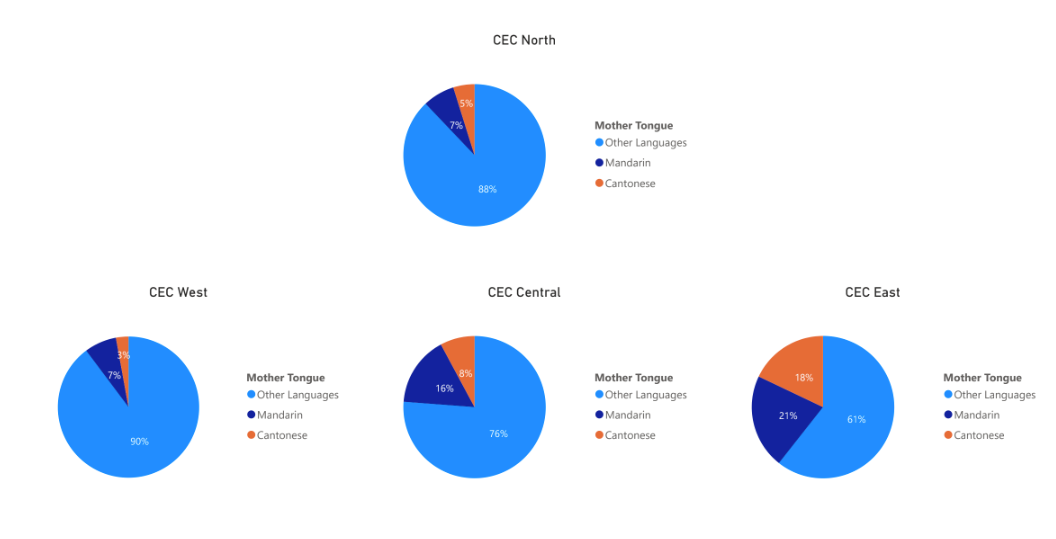 Based on YRDSB Student Information System School Year from 2017-2018 to 2022-2023. Data provided by the York Region District School Board, Research & Assessment Services.
Based on YRDSB Student Information System School Year from 2017-2018 to 2022-2023. Data provided by the York Region District School Board, Research & Assessment Services.
The two written forms of Chinese are Simplified and Traditional. Cantonese and Mandarin and the many Chinese dialects can be written in either Traditional or Simplified. This means it’s possible for speakers of different languages to be able to communicate in writing.
Nancy Siew grew up in Hong Kong in a bilingual household. Listen as she explains the challenges between understanding the differences between Simplified Chinese and Traditional Chinese:

 This photo shows some of the tools used in Chinese calligraphy. This calligraphy set consists of: (left to right) water flask, seal and seal paste, washer, brushes and brush rack, brush pot, paperweight, brush, ink stick and slate. Courtesy of Henry Yuen, On loan to Markham Museum.
This photo shows some of the tools used in Chinese calligraphy. This calligraphy set consists of: (left to right) water flask, seal and seal paste, washer, brushes and brush rack, brush pot, paperweight, brush, ink stick and slate. Courtesy of Henry Yuen, On loan to Markham Museum.
Chinese writing doesn’t use letters that represent sounds like in English. Instead it uses characters, which are groupings of strokes written in a set order that represent a word. Calligraphy, or the art of writing, is a visual art form that is closely related to Chinese painting. Like painting, calligraphy is done with brushes and ink on paper.
To learn more about Chinese calligraphy and how to write Chinese characters, visit the Kennedy Center’s lesson plan on Chinese Calligraphy and Ink Painting.
Take a closer look at the two characters. What about them looks similar? What looks different?
In Simplified Chinese, the word for ‘learn’ is written as 学 while the same word in Traditional Chinese is written as 學.
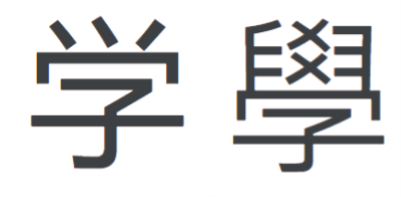
Immigration Journeys
The many pathways to Canada are as diverse as the people who take them. When waves of arrivals to Canada came in the late 1700s, including people from the Chinese community, there was a change in the relationship with the land. Newcomers responsible for clearing Indigenous land, pushed those Indigenous communities out, and the systematic mapping and division of the land began. Most Canadians are immigrants to the land we call Canada, except for First Nations, Inuit and Métis peoples.
Some of the Chinese diaspora made the land that is now known as York Region home. The path to Canada can take many years to complete, even today depending on where you’re coming from. For families who were unfortunately separated by the Chinese Exclusion Act of 1923, wives and children were disallowed to join husbands and fathers in Canada, leaving many families who painfully had to wait until the act was removed in 1947 before completing the journey and reuniting. Some families never had the chance to reunite.
Vancouver, Montreal, and Toronto are cities where newcomers frequently start out. People of Chinese descent have long established Chinatowns in each of these city centres. Toronto has had three distinct Chinatown communities, beginning in 1900. Originally part of The Ward (bordered by Yonge Street, University Avenue, College Street and Queen Street), this original Chinatown area of Toronto was home not only to the growing Chinese population, but also the Black community, Irish, Italians, Eastern European and Jewish newcomers all lived here together. Many businesses and residents had their land expropriated in the 1950s, then demolished in 1965, to make way for urbanization and revitalization. The demolition of this first Chinatown in Toronto resulted in an additional two ethnically Chinese areas: Chinatown West and Chinatown East.
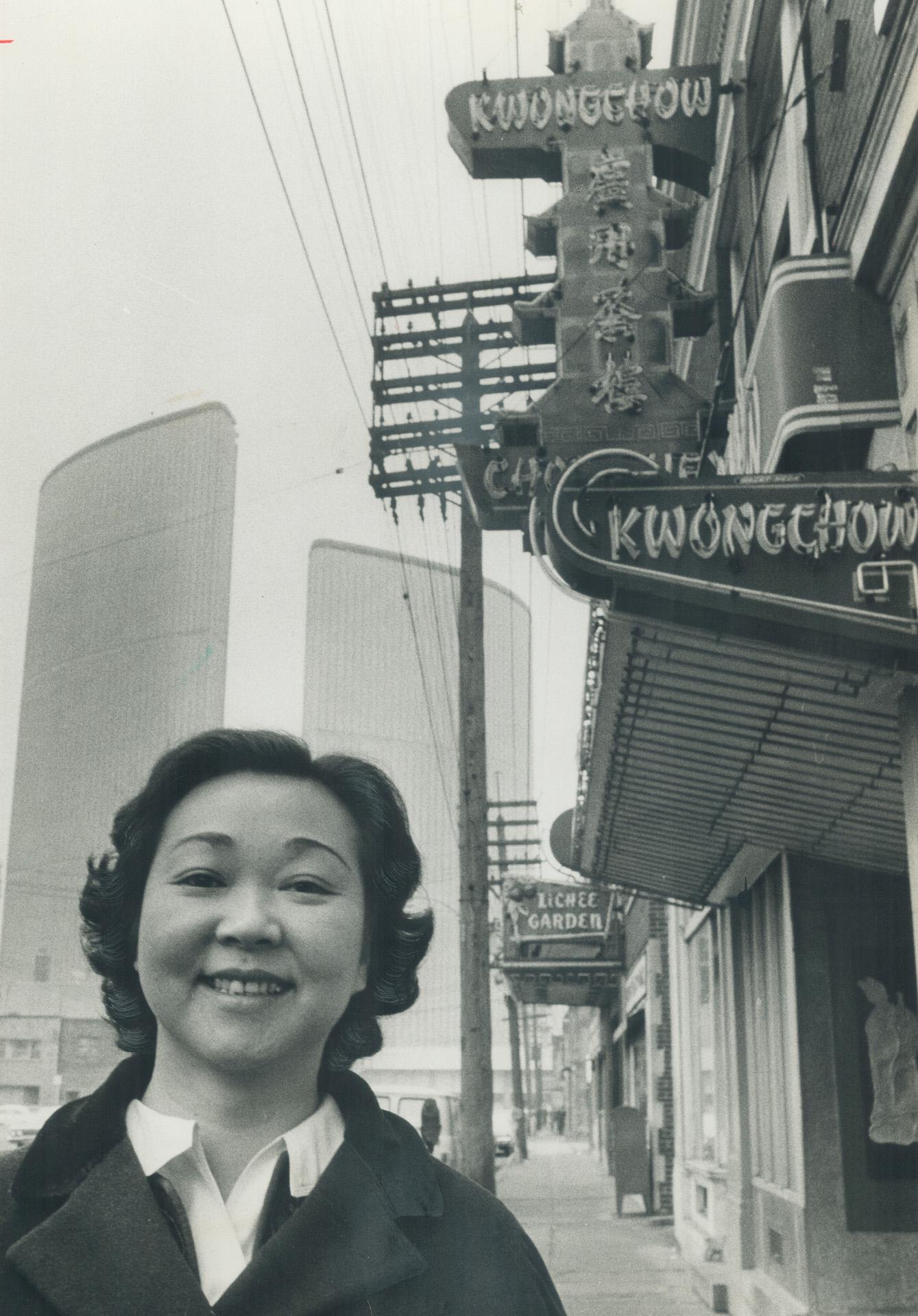 Jean Lumb standing in Chinatown with City Hall in the background. 22 January 1967. Toronto Public Library.
Jean Lumb standing in Chinatown with City Hall in the background. 22 January 1967. Toronto Public Library.
|
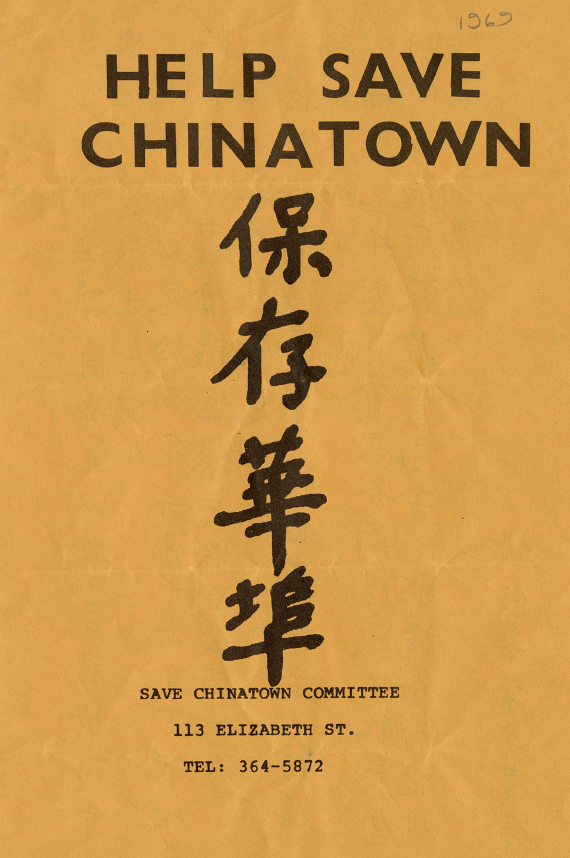 Help Save Chinatown pamphlet. 1969. Toronto Public Library.
Help Save Chinatown pamphlet. 1969. Toronto Public Library.
|
Restaurateur and social activist Jean Lumb used the popularity of her businesses to support Chinese arts and granted opportunities for women. In the late 1960s, she was instrumental in organizing a campaign to save Toronto’s Chinatown from demolition. She was the first Chinese Canadian woman and first restaurateur to receive the Order of Canada for her community work. In 1957, she met Prime Minister John Diefenbaker while lobbying for Chinese family unification.
Today the Jean Lumb Foundation is a not-for-profit that provides scholarships to high school students of Chinese heritage. A number of YRDSB students have been recipients of this prestigious and recognized award.
In this video by Myseum of Toronto, watch Arlene Chan speak about her mother, Jean Lumb.
While large cities like Toronto, Montreal and Vancouver are often the first arrival point for many new immigrants, not all new arrivals stay in these cities. For instance, Dr. Keith Lowe’s father came from China to Vancouver, then took the train to Halifax, and followed by a ship journey to Jamaica (listen to his story below). To this day, there remains deep connections between Canada and the Chinese Jamaican community.
Members of the Chinese community who are born here in Canada are often referred to as “CBC” or “Chinese-born Canadians.” Some Chinese-born Canadians learn Mandarin, Cantonese or another Chinese dialect at home while some individuals choose only to learn English. Given the strong connections between Canada and their places of birth, some, like Lily Liang, travel back and forth between China and Canada. While growing up, Lily was like many young Canadians who lived with her family in China until she was old enough for her parents to register her for school. After moving back to Canada, Lily attended Unionville High School.
> Listen to her story below as she explains her strong connection to the Markham community.
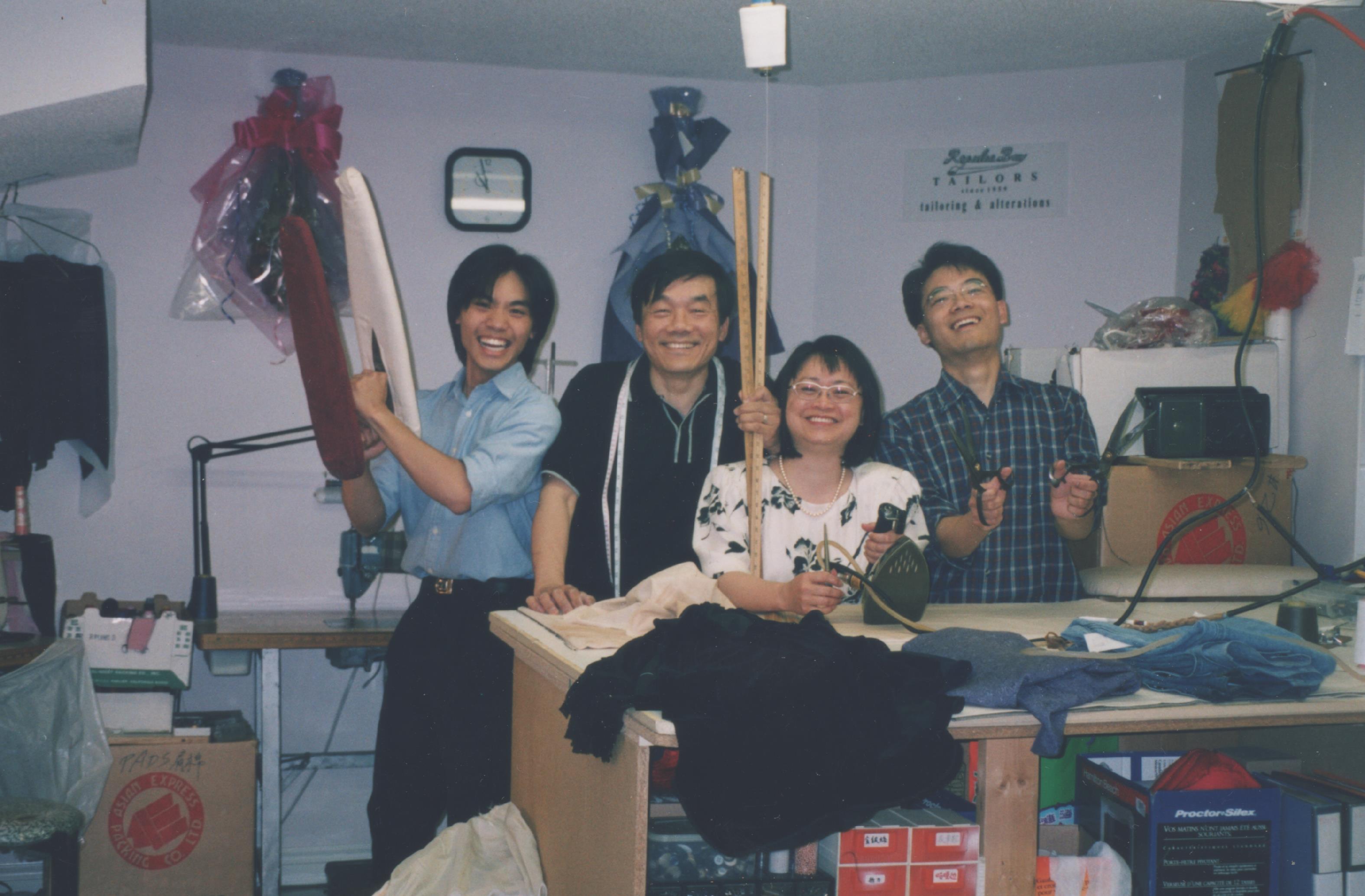 Sung family celebrating the move of their business to their home basement, 2000. Courtesy of Sung family.
Sung family celebrating the move of their business to their home basement, 2000. Courtesy of Sung family.
As housing prices have increased throughout the Greater Toronto Area, many people choose to move further north. While Toronto has two main Chinatowns, some people continue their immigration journeys to places such as Agincourt, Richmond Hill, Markham, Aurora, Newmarket, and Stouffville. This has created unique "ethnoburbs" in several York Region cities. Markham in particular has remained a significant destination for migration and continues to grow annually, attracting people from all over the world as the ‘High Tech Capital’ of Canada. It has over 1500 technology companies that employ over 37,000 people. This has provided opportunities for people from all different types of backgrounds to move to York Region.
Representation is important to open doors for more diverse voices and different perspectives to be heard. The voting rate among the Chinese Canadian community was quite low in 2010, with only about 12% getting out to the polls. Regional Councillor Alan Ho originally was elected as a Markham Ward Councillor, and regularly canvased for the community to get out to vote. He has been representing his constituents for over 12 years.
Listen to these community members as they give insight into their personal stories:





The Many Different Immigration Pathways to York Region: The Hakka People
The path to Canada for people of Chinese descent includes many diverse routes. War often forced many to flee China, and the Hakka people, originally from Northern China, migrated to places like India, Taiwan, Malaysia, Mauritius, Thailand and even the Caribbean. Their language dialect is a bridge between Mandarin and Cantonese, known as Hakka.
As it is in various parts of China, The Hakka Chinese enjoy a different food culture. Hakka cuisine tends to have more stir-frying, steaming and braising. It is also spicier than many other types of Chinese foods. There are many restaurants that are distinguished as Hakka cuisine in York Region and are enjoyed by many, not just Hakka Chinese. Since 2014, Toronto has held an annual Toronto Hakka Festival to share and celebrate their food and culture.
| Did you know? |
|---|
| The word “Hakka” means “guest people" in Mandarin. |
Markham Regional Councillor, Joe Li, was born in India in 1974 and is a member of the Hakka Chinese community. He and his family left India because of anti-Chinese sentiment. Listen as he speaks about his experiences growing up in a traditional Chinese family and as a member of the Hakka Chinese community.
"I cannot deny the fact I’m Indian by birth, neither can I deny the truth I’m Chinese by descent. But I’m Canadian by choice."
- Markham Regional Councillor Joe Li
Carlton Wong
Carlton Wong was born in Guangdong, China, but during the Sino-Japanese War he fled to Jamaica. In Jamaica, Carlton spoke Hakka with his family but learned to communicate using English and Jamaican Patois as he grew up, went to school, and began to work. As an adult, Carlton worked as a shop owner but had to leave with his family in 1966, due to social unrest and increasing anti-Chinese sentiment. From there, he and his family of five moved to Scarborough, and upon arrival, he got a job as a textile factory worker. In order to join or participate in the Chinese community in Canada, Carlton had to learn Cantonese because there were more Cantonese speakers at that time than Hakka. It was also a difficult adjustment for his children. His son, Brian said “From the perspective of a 12 year old, it was scary… I didn’t know how to navigate socially. My accent separated me from others. Kids wouldn’t understand my Jamaican accent or they would laugh at me. I didn’t feel ethnically different from other people as much as I did culturally.”
Over his lifetime while living in Markham, Carlton continued to learn and speak Cantonese. His wife, Margery, always spoke English to the family, even though she also spoke and understood Hakka. Their granddaughter, Kristen Wong, felt a similar struggle growing up between the Chinese-Jamaican and Canadian culture.
I recall being told that I was “not a real Chinese” because I couldn’t speak the language and because I called my paternal grandparents, Po Po and Gong Gong… I recall feeling really bad about this. Like I wasn’t “Chinese enough” to even call my grandparents the right names. But how was a little girl growing up between the Chinese-Jamaican and Canadian cultures supposed to know that? It was a slight difference in dialects but it made me feel like I didn’t belong.
Now, many years later, I still live in York Region. I met my husband, got married, and am now raising my family in the same municipality I grew up in. I grew to understand my Chineseness and the unique pathway my family took to Canada - and it’s beautiful.”
Many of the descendants of Carlton and Margery Wong continue to live and work in York Region.
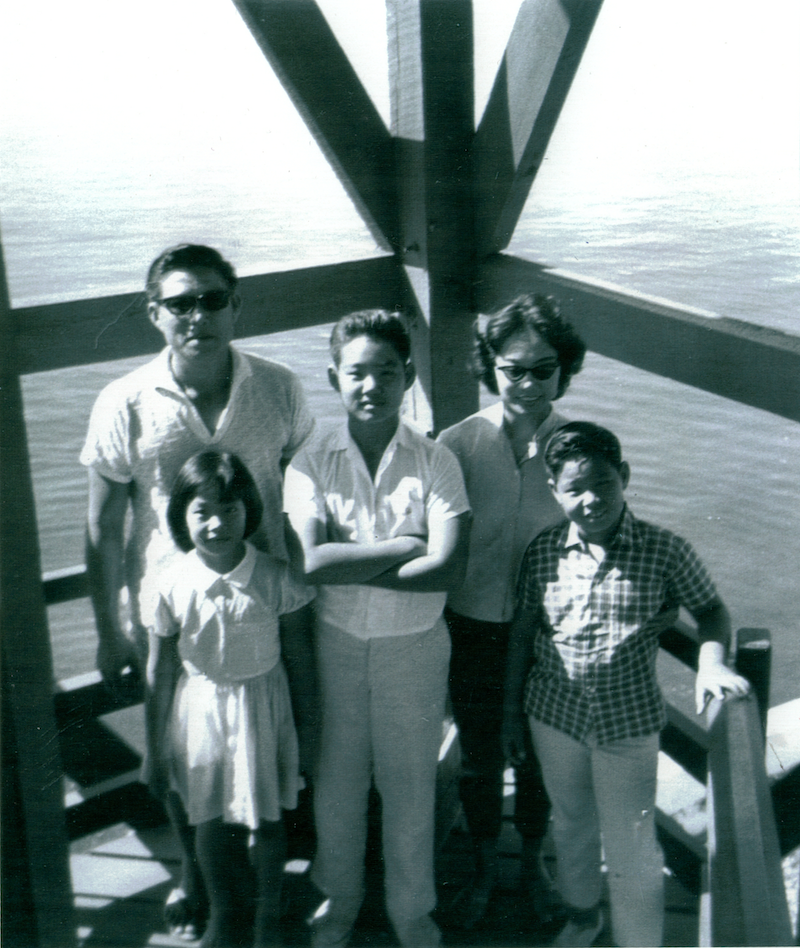 The Wong family leaving Jamaica in 1966.
The Wong family leaving Jamaica in 1966.
|
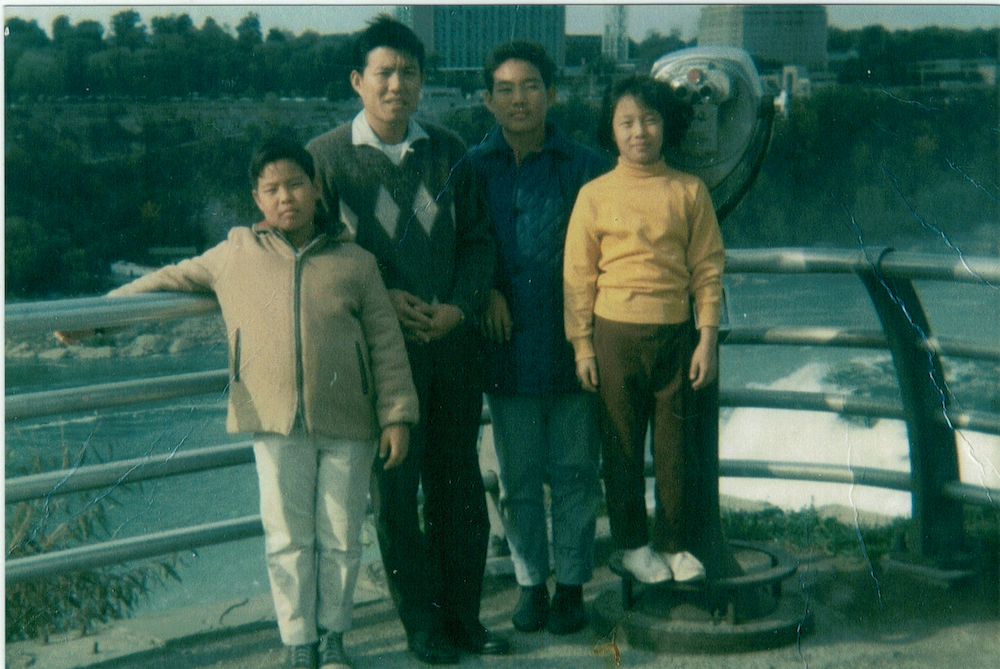 Upon arrival in Canada, the Wong family did what many new residents do - they visited the iconic Niagara Falls. 1966.
Upon arrival in Canada, the Wong family did what many new residents do - they visited the iconic Niagara Falls. 1966.
|
Dr. Keith Lowe
Another important member of the Hakka community is Dr. Keith Lowe. Dr. Lowe’s father came to Jamaica from China, travelling through Canada by train, with one of his brothers in 1911 at the age of 25. He operated a shop called, James Lowe and Brother, and the children were expected to work the counter. At the age of 43, he arrived in Toronto. Despite having degrees from Harvard, Stanford and having worked as a Curriculum Supervisor in Jamaica, the Ontario Ministry of Education only accepted his grade 13 credentials, and did not recognize his eligibility for a teaching position. It wasn’t until Dr. Lowe came to Canada where he identified himself as Hakka. In Jamaica, he identified himself as Chinese.
In 1984, he joined a working group called the Special Parliamentary Committee on Visible Minorities to prepare a policy document on race relations in Canada. Together with a team, they released the document called “Equality Now!” This groundbreaking document made a number of important recommendations to the Canadian government, including a new policy on multiculturalism. Dr. Lowe, who once couldn’t get a position as an Ontario school teacher, has been instrumental in improving race relations through policy recommendations to government and school boards for decades.
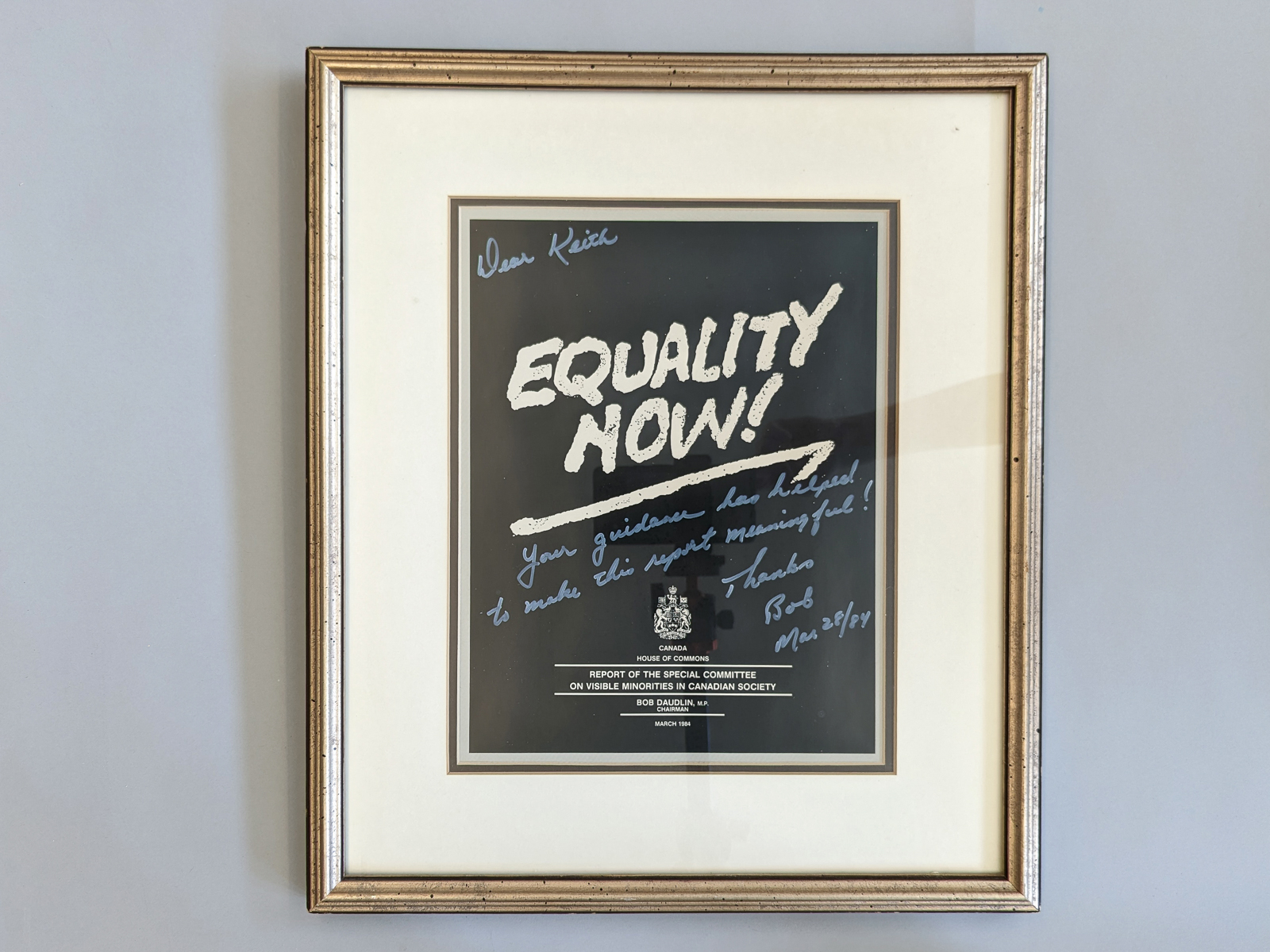 Report of the Special Committee on Visible Minorities in Canadian Society, signed. March 1984. Courtesy of Dr. Keith Lowe.
Report of the Special Committee on Visible Minorities in Canadian Society, signed. March 1984. Courtesy of Dr. Keith Lowe.
In 2022, Markham held the 31st World Hakka Conference. Thousands of people from the Hakka diaspora visited Markham and celebrated this rich and diverse community.
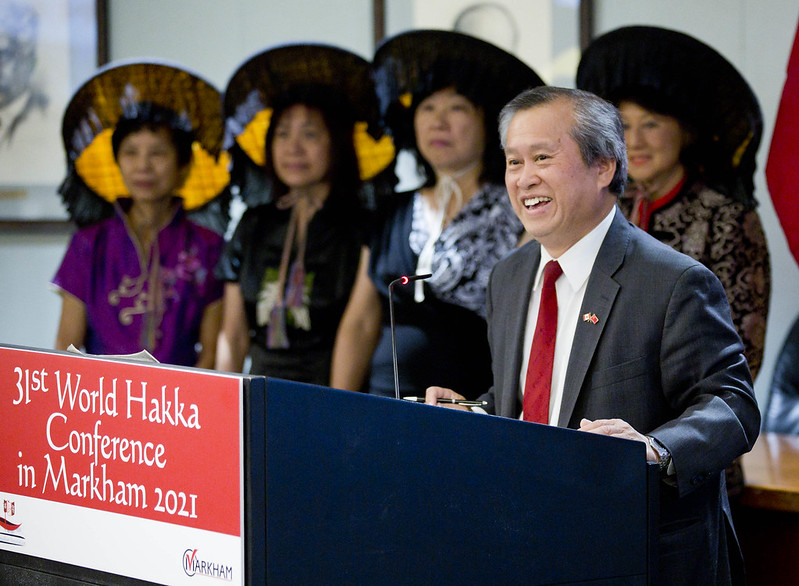 Regional Councillor Joe Li announcing 31st World Hakka Conference in Markham, 2021.
Regional Councillor Joe Li announcing 31st World Hakka Conference in Markham, 2021.
Ethnoburbs are suburban residential and business areas where an ethnic group makes up a significant portion of the population. They are often in higher income, car-friendly, suburban cities. Ethnoburbs contribute to the creation of multicultural and diverse cities. Markham, where 45% of the population identifies as Chinese, is one of many ethnoburbs in Canada.
The Changing Landscape of York Region
The Chinese community has made a lasting impact in York Region and many have made it their home. They have established businesses, community centres, and important landmarks for all York Region residents. When you move through York Region, you might see stone lions, Chinese gates, and other hallmarks of Chinese architecture that serve as reminders that the Chinese community is part of the landscape of York Region.
|
Yangtze Pagoda Restaurant 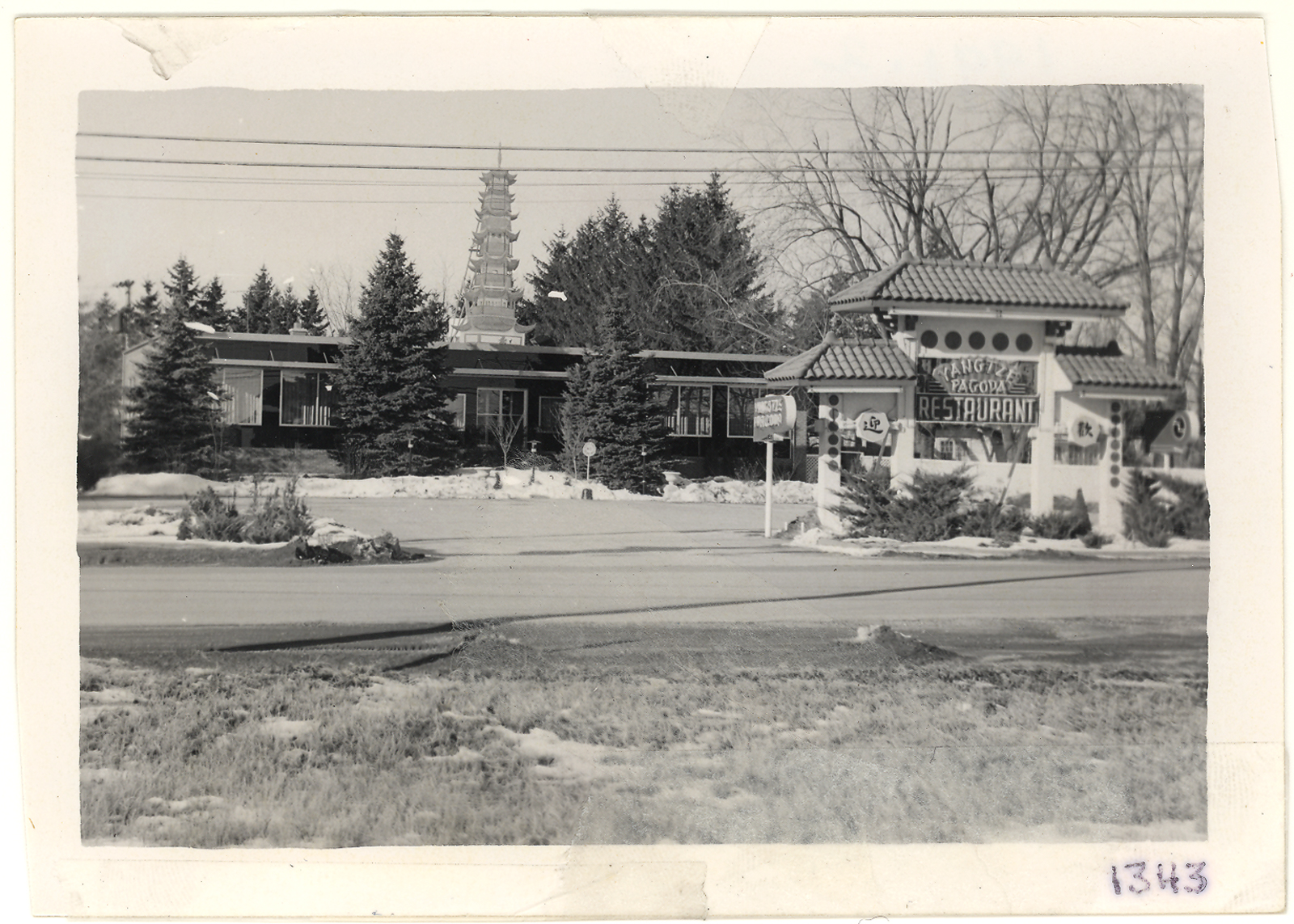 Courtesy of Richmond Hill Public Library, Local History Room collection
Courtesy of Richmond Hill Public Library, Local History Room collection
|
|---|
|
In 1958, Lew Hein opened the Yangtze Pagoda restaurant at the corner of Yonge Street and Oxford Street in Richmond Hill. With seating for 300, it was the site of wedding receptions, cultural celebrations and community gatherings. The restaurant employed a staff of 30 until it closed in 1971. |
From schools to malls to cultural centres, listen to community members talk about local places of significance to them. Educator Jadas Lau speaks about her connections to her school, Nokiidaa Public School in Markham and her local church community. Rev. Danny Leung, a disability advocate, speaks to the importance of his coffee shop, Joy Beyond Vision Community Café. The JBVC Café provides meaningful employment for visually impaired persons to help them regain independence. He also speaks about the importance of sidewalks to the visually impaired community and how York Region helped provide a sidewalk to the community near 105 Gibson Centre. Having an accessible sidewalk for the Café has made it safer and more welcoming to everyone visiting.



Making Community in our Places and Spaces
As Chinese immigrants settled in York Region and developed strong ties to the area, they attracted other Chinese immigrants to settle nearby. Developers would send brochures and put ads in Chinese newspapers in mainland China, Hong Kong, and Taiwan to entice potential immigrants to York Region. New immigrants sometimes buy houses or storefronts before even setting foot in Canada.
Shopping centres like Pacific Mall, Market Village and King’s Square in Markham and Times Square in Richmond Hill are commercial, cultural and community hubs. In addition to shopping and dining, these tourism destinations host cultural celebrations like Lunar New Year to engage new communities and honour old traditions. These malls are places for new communities to be built and old traditions to be honoured. Some malls, like Times Square and Pacific Mall, share names with large shopping centres in Hong Kong, creating a bridge between North America and Hong Kong.
 Interior of Pacific Mall, 2023. Courtesy of City of Markham.
Interior of Pacific Mall, 2023. Courtesy of City of Markham.
|
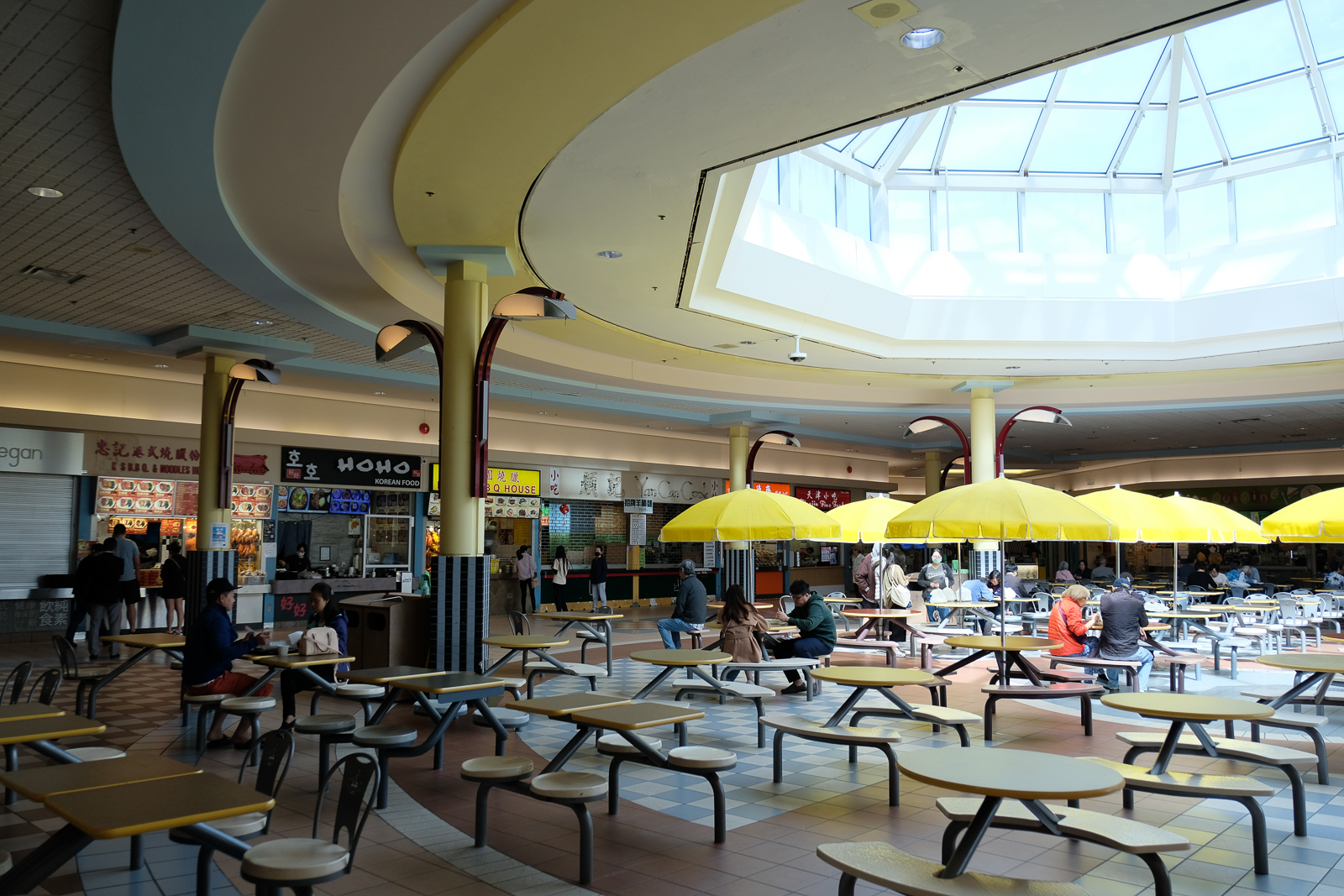 First Markham Place food court. Courtesy of City of Markham.
First Markham Place food court. Courtesy of City of Markham.
|
Malls provide an opportunity for social gatherings. Listen to Dr. Keith Lowe as he discusses the importance of malls as a cultural and social meeting point for members of the older Chinese community in York Region:

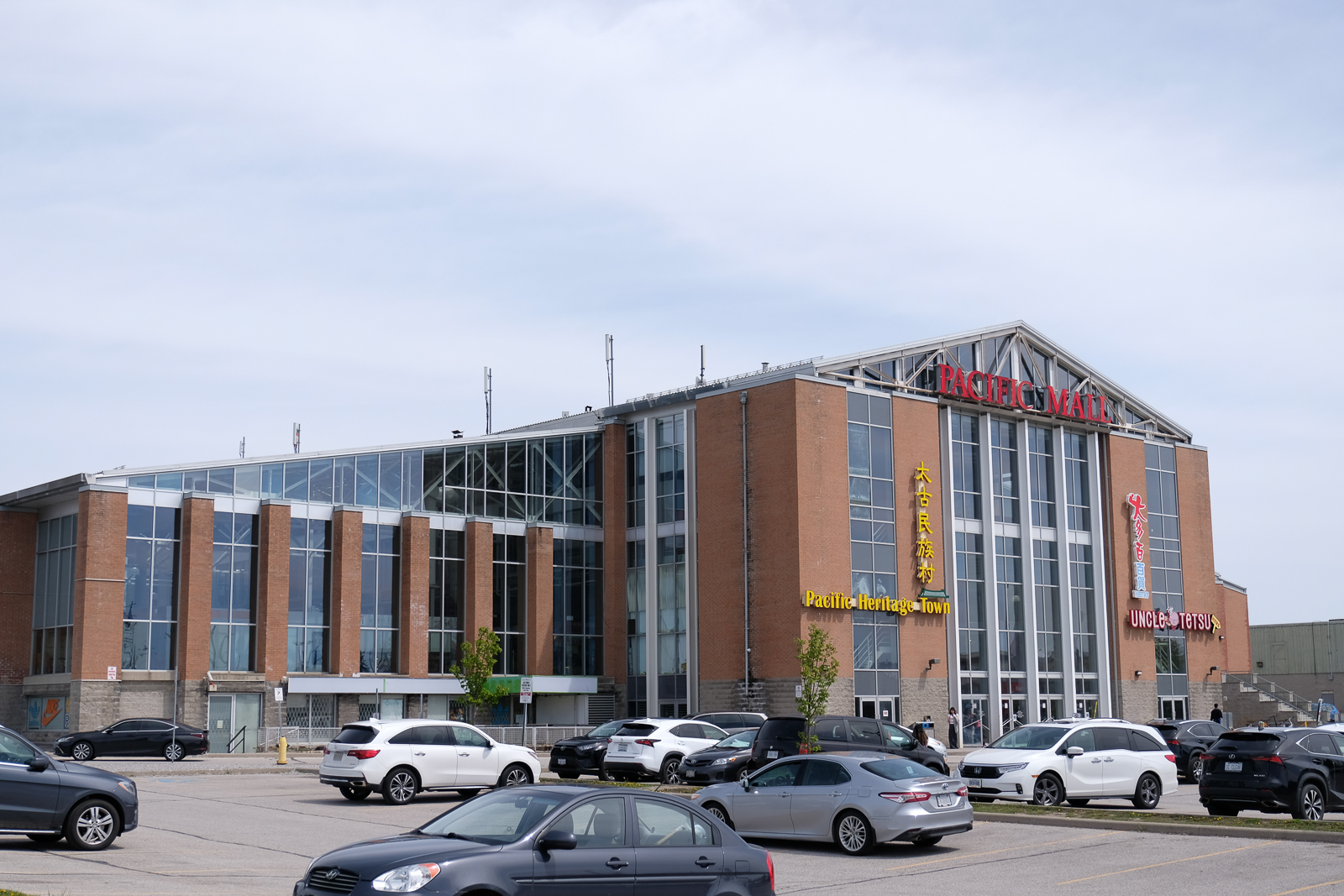 Pacific Mall, 2023. Courtesy City of Markham
Pacific Mall, 2023. Courtesy City of Markham
|
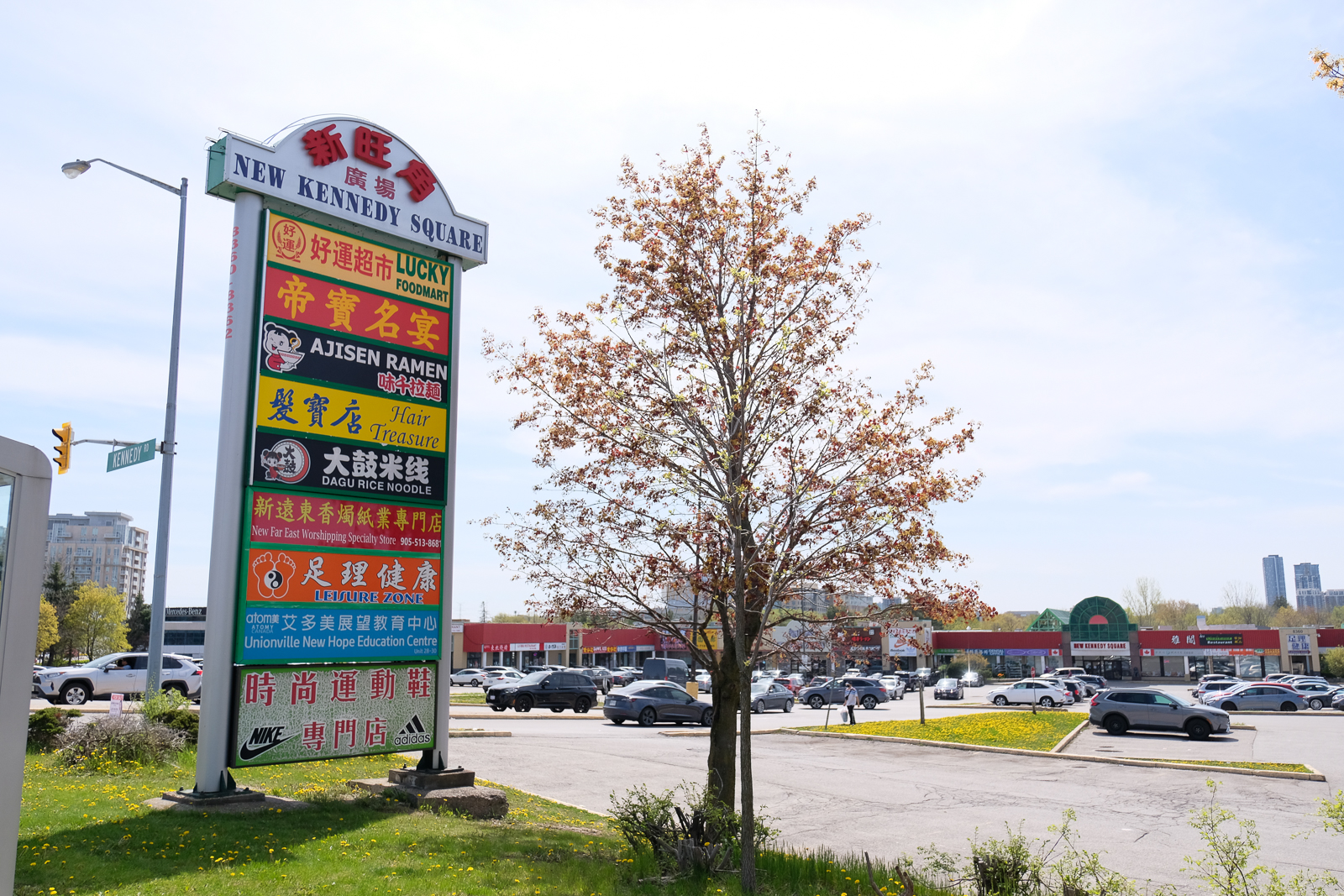 New Kennedy Square, 2023. Courtesy City of Markham.
New Kennedy Square, 2023. Courtesy City of Markham.
|
Chinese malls have always been important places for the Chinese community, but the Chinese language signage hasn't always been embraced by other York Region residents. The increasing Chinese population in York Region made some of the white residents in the area uncomfortable. In 1995, then-Deputy Mayor of Markham, Carole Bell, said that Chinese-only signs made Markham’s white population feel unwelcome and that “everything’s going Chinese.” (Toronto Star, 1995)
In protest of the racist comments from Carole Bell and other residents, Dr. Ken Ng and other members of the Chinese community coordinated with concerned and racialized residents to address this racism. Local area mayors all signed a petition. After making national headlines, the Chinese Canadian community and supporters demanded an apology from Markham Council. Council agreed with community members and this resulted in the establishment of a race relations committee.
Today, Chinese malls and plazas are a testament to the Chinese community’s resilience and rich business and culture.
In 2003, the severe acute respiratory syndrome (SARS) outbreak occurred in the Greater Toronto Area. In one attempt to control the virus spread, the students and staff at Markham’s Father Michael McGiveny Catholic Academy were placed under quarantine after a student demonstrated symptoms. Fear and misinformation about the virus led to stigma and discrimination against Chinese restaurants, businesses, and people of Chinese descent across York Region. This resulted in great economic losses for Chinese businesses.
Anti-Asian racism and discrimination that arose from the SARS epidemic in the early 2000s was very similar to the COVID-19 outbreak 20 years later. The number of racist acts and xenophobic violence increased not only in York Region but across Canada. Community members are often subjected to racism based upon their ethnicity. This occurred to many members of the Asian community, not only those of Chinese descent. Listen to one member of the community, Cindy Keung, talk about her experience during the pandemic:
I remember at the very beginning [of the pandemic], once, and only once, I went to the grocery and I saw the cashier is very unhappy face when I go to the counter. And it felt like - "you are spreading the virus." That was a very bad experience. But I think in every country there are good and bad people, right? ...But most of the time here, I feel good. I feel good because Canada is a multicultural country.
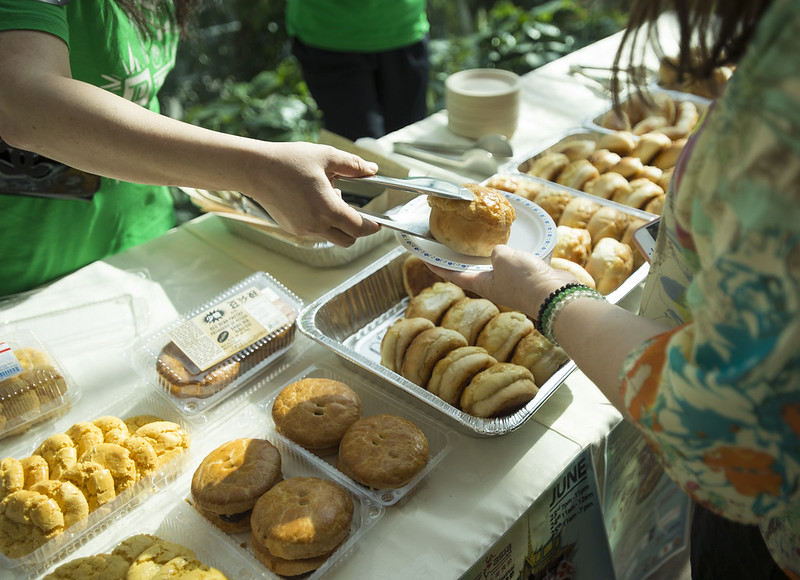 Serving food, Taste of Asia event, 2017. Courtesy City of Markham.
Serving food, Taste of Asia event, 2017. Courtesy City of Markham.
The Taste of Asia was started by the Federation of Chinese Canadians (FCCM) in 2003 following the SARS outbreak to help support the local economy. This outdoor cultural celebration is the largest Asian festival in Canada, and features a variety of food, concerts, guest speakers, dance acts, and martial arts performances. Ritch Lau, who frequently visits this annual event, speaks about the Taste of Asia’s importance and its ability to showcase diverse aspects of Chinese culture. Over 300,000 visitors attend this event organised by the FCCM, the Municipality of York Region, and the Association of Progressive Muslims of Canada (APMC).
Listen to Dr. Ken Ng, Chairman of the Federation of Chinese Canadians and organiser of the Taste of Asia, as he speaks about the significance of this cultural festival to bring the community together and create a sense of belonging.
Many Chinese restaurants were especially negatively impacted, especially Wuhan Noodle 1950 in Markham, which experienced months of racist comments on social media, poor online ratings and prank phone calls. Community leaders and local politicians supported this restaurant, condemning anti-Chinese racism, by visiting and showing their support.
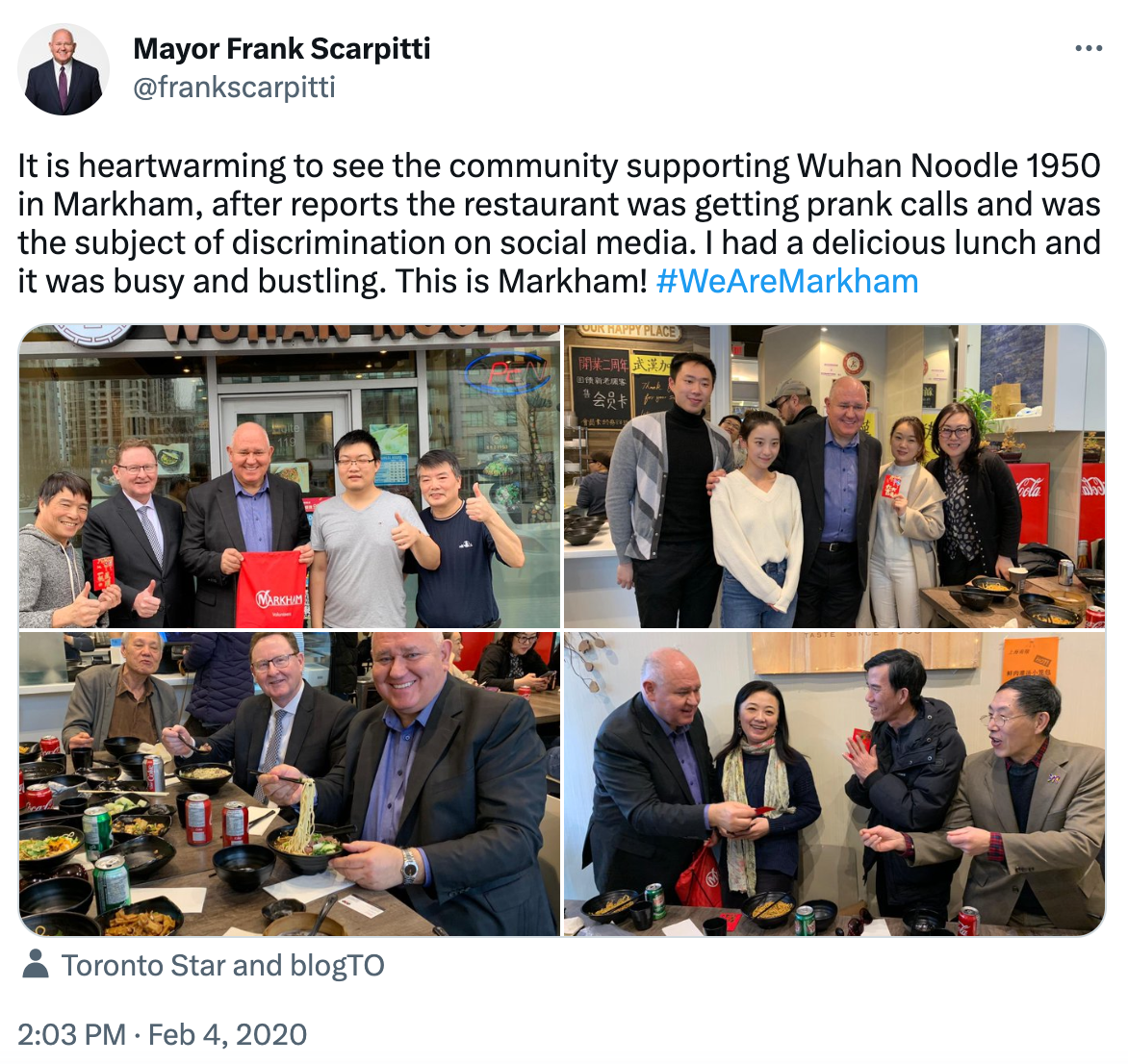
|
Did you know? |
|---|
|
Pacific Mall in Markham is currently the largest indoor Chinese shopping centre in North America. Opened in 1996, it was the second Asian themed mall built in Markham, following Market Village which opened in 1990. In 2000, the York Regional Council designated the Pacific Mall/Market Village complex an official tourist spot. The complex is often on the itinerary for Chinese tour groups. Pacific Mall’s success and significance has paved the way for other large Chinese shopping centres across Canada. King’s Square, also in Markham and completed in 2018, now claims to be the largest Chinese retail complex in North America. Councillor Ritch Lau shares some of his first memories of Pacific Mall when he first arrived in Canada 20 years ago:
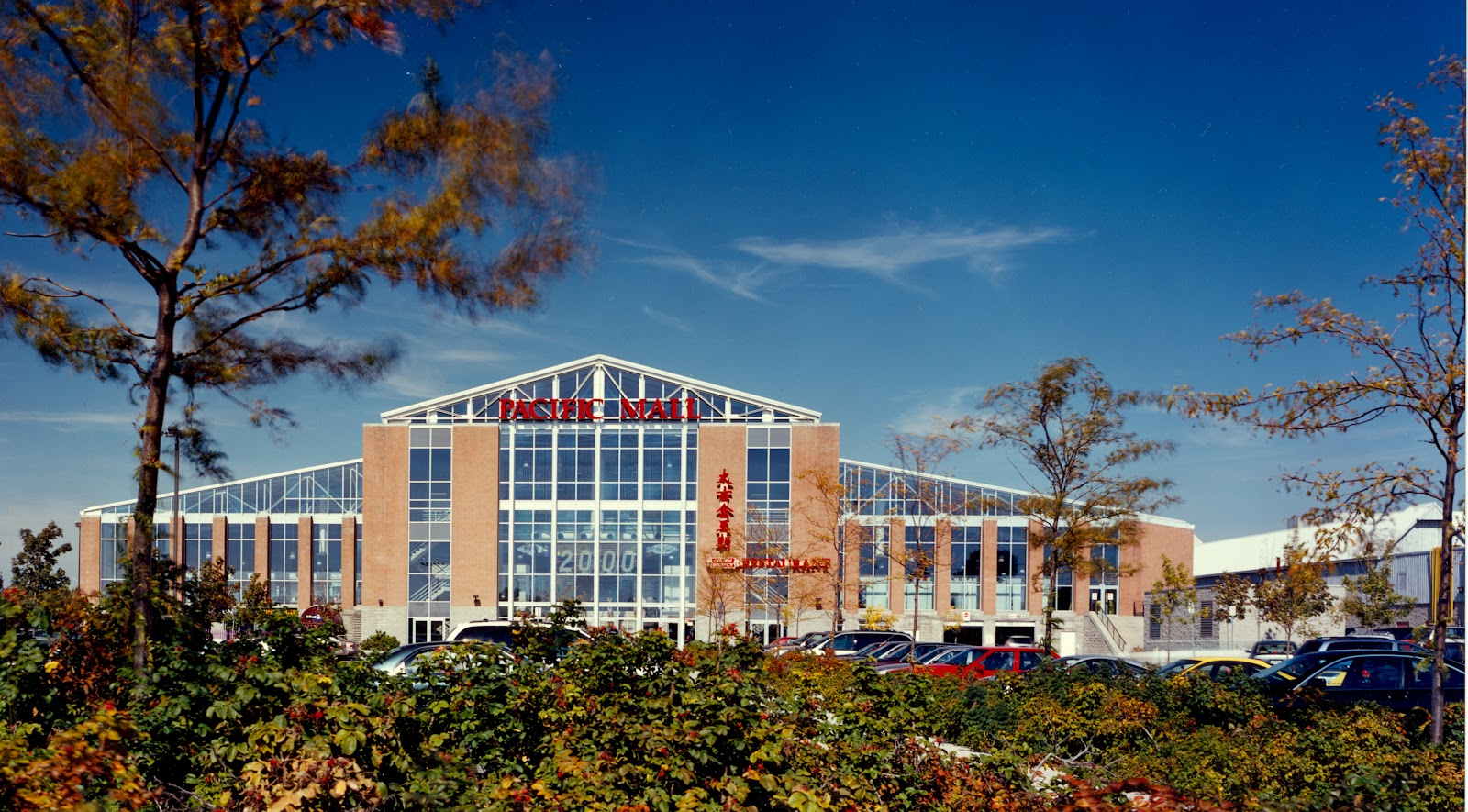 Opened in 1996, Pacific Mall is open daily year-round. Similar to a shopping experience in Hong Kong or Beijing, this mall has fashion stores, tea shops, gift items, herbalists, and restaurants.
Opened in 1996, Pacific Mall is open daily year-round. Similar to a shopping experience in Hong Kong or Beijing, this mall has fashion stores, tea shops, gift items, herbalists, and restaurants.Markham Museum. M.2012.16.10 |
The Apology
During the time that the Head Tax was in place (1885-1923), nearly $23 million was paid to approximately 82,000 Chinese immigrants to Canada. Newfoundland maintained their own $300 head tax from 1906 until 1949, when Newfoundland and Labrador joined Confederation.
The Chinese Canadian community began seeking correction for the anti-Chinese immigration policies shortly after the repeal of the Act in 1947. Decades later, in 1983, Dak Leon Mark and Shack Yee asked their local Member of Parliament for a refund on their $500 head tax payment. While it was denied, this action inspired thousands to also come forward for redress. Some community members wanted an apology while others wanted financial compensation. It took over twenty-two years of negotiations with the federal government and community groups from the Chinese Canadian community to reach an agreement. Many from the community felt this long delay demonstrated a strong reluctance by the government to admit they were wrong and to attempt to rectify the situation.
On 22 June 2006 the newly elected Prime Minister Stephen Harper apologized to head-tax payers, their families and the Chinese Canadian community. He apologized for the “grave injustice,” both the head tax and the Chinese Exclusion Act.
The government of Canada recognizes the stigma and exclusion experienced by the Chinese... We acknowledge the high cost of the head tax meant many family members were left behind in China, never to be reunited, or that families lived apart and, in some cases, in poverty, for many years. We also recognize that our failure to truly acknowledge these historical injustices has led many in the community from seeing themselves as fully Canadian.
Therefore, Mr. Speaker, on behalf of all Canadians and the Government of Canada, we offer a full apology to Chinese Canadians for the head tax and express our deepest sorrow for the subsequent exclusion of Chinese immigrants.
Gar nar dai doe heem." - Prime Minister Stephen Harper
Video: June 22, 2006 - Harper Government Issues Full Apology For Chinese Head Tax and Chinese Exclusion Act
The federal government pledged funds for educational projects to commemorate and educate on the historical contributions of Chinese Canadians. They also offered symbolic payments of $20,000 to each head tax survivor and the surviving spouses. There were mixed reactions to the redress. Some accepted the apology while others felt the payment came too late, since many of the head taxpayers had already passed away.
Head Tax payer Norman Tom often told his family, “I had to pay a three hundred dollar head tax to get into Newfoundland. Life was not easy. It was a lot of money, about three years of wages.” Norman was one of the last Chinese immigrants to Newfoundland required to pay the head tax. Dated March 29, 1949, his head tax certificate was number 377 out of 384. His father, Sing Tom, also paid the head tax upon his arrival in 1929. Sing Tom immigrated from the agricultural area of Guangdong Province to Newfoundland, where he worked as a laundryman for many years. Once he saved enough money, he opened and operated a general store. Like many Chinese families, Sing Tom’s wife To Heung and their children remained in China because of the cost of the head tax.
In 1949, the family paid $300 for Norman to come to Newfoundland. After Newfoundland and Labrador joined Canada on 31 March 1949, Tom’s family could be reunited without having to pay the head tax for the additional family members. In 1951, the rest of the family immigrated to Newfoundland after 22 years of living apart.
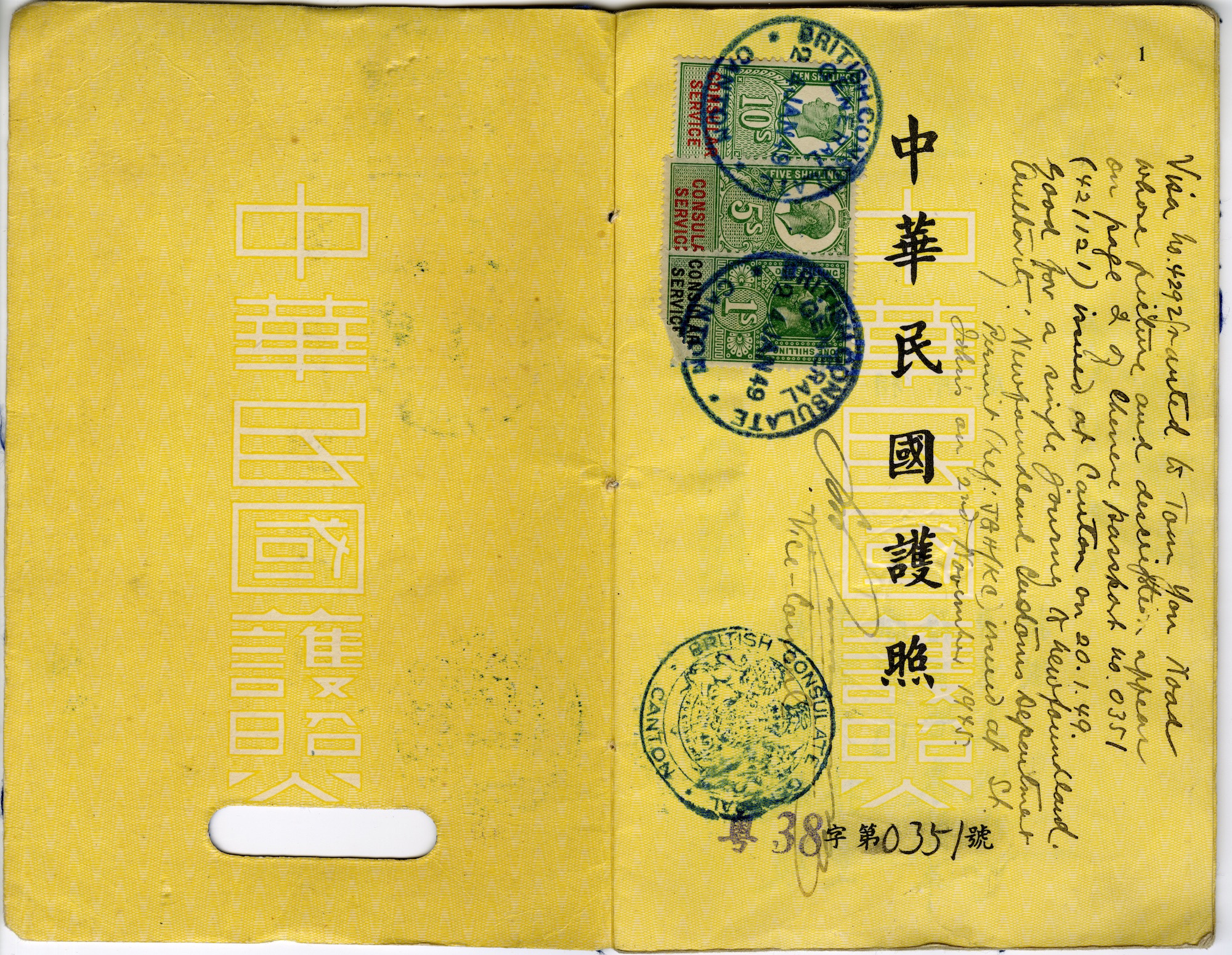 Norman Tom’s Chinese passport. Courtesy of Wilman Tom.
Norman Tom’s Chinese passport. Courtesy of Wilman Tom.
|
 Copy of Norman Tom's Head Tax. Courtesy of Wilman Tom.
Copy of Norman Tom's Head Tax. Courtesy of Wilman Tom.
|
Identified as “Tom You Noad,” Norman kept this Head Tax Certificate locked away with his important papers. Just days after his arrival in March 1949, Newfoundland joined Confederation, ending the head tax requirement for Chinese immigrants.
In 1976-77, Norman and his wife immigrated to Toronto, where he operated a convenience store. In 1993, he retired but remained in Ontario. Since 1995, many of Norman’s descendants have lived in Markham and Richmond Hill.
 In celebration of the Lunar New Year, Norman Tom, surrounded by his wife and family, accepted the federal apology, handshake and cheque in February 2007. As only the 38th Chinese Head taxpayer to receive the redress, he gave the $20,000 to his family and two charities. Courtesy of Wilman Tom.
In celebration of the Lunar New Year, Norman Tom, surrounded by his wife and family, accepted the federal apology, handshake and cheque in February 2007. As only the 38th Chinese Head taxpayer to receive the redress, he gave the $20,000 to his family and two charities. Courtesy of Wilman Tom.
Making Home in Canada
Cultural diversity is a hallmark of Canadian society, as people from all over the world have settled in Canada. Chinese Canadians, like many immigrant communities, have brought their cultures and traditions with them to Canada while adapting to life in a new country. Cooking traditional dishes, following traditional customs, or decorating their houses with Chinese elements helps them stay connected to their heritage.
Coming to Canada meant having to choose what to bring and what to leave behind. Learn about some of the things that Chinese immigrants brought with them to Canada. Think about why these objects might have been chosen and what they can tell us about the person who owned them.
Clothing
This dress belongs to Nancy Siew and was brought to Canada from Hong Kong when she immigrated in 1976. This is a traditional Qun Gua or guaqun. It is a traditional two piece ceremonial wedding dress. It is heavily embroidered, completed by a master tailor, with depictions of dragons and phoenixes. The designs are full of rich symbolism.
The jacket is known as the gua. The qun is the pleated skirt. These two items are covered in hand-detailed embroidery. The fabric is red, with gold and silver embroidery. The Qun (skirt) is so heavy, it requires shoulder suspenders to hold it in place.
Calligraphy
These calligraphy brushes and brush rack belong to a calligrapher. Calligraphy is a high valued Chinese art form and each of these tools serve a specific purpose for the calligrapher.
The brush rack ensures that the hair on the brushes remains straight and each brush, made from different types of hair and of varying softness, behaves differently and allows for different brush strokes.
Musical Instruments
Music offers an important connection for immigrants of all cultures. The ruan is a traditional Chinese plucked string instrument. This ruan belonged to Gunson Mah, who came to Canada in 1923 at the age of twelve. Mah was passionate about Chinese opera and played in a band called the Jin Wah Sing Musical Society. He brought this ruan to Canada after his last visit to China and Hong Kong in the 1960s.
Similarly, Markham City Councillor Isa Lee brought her guzheng to Canada. Isa attended Middlefield Collegiate Institute for her last year of secondary school. Coming from Hong Kong, she continues to this day to play her guzheng. The guzheng is a multi-stringed Chinese instrument. Listen as she describes sharing this musical instrument with her high school community.


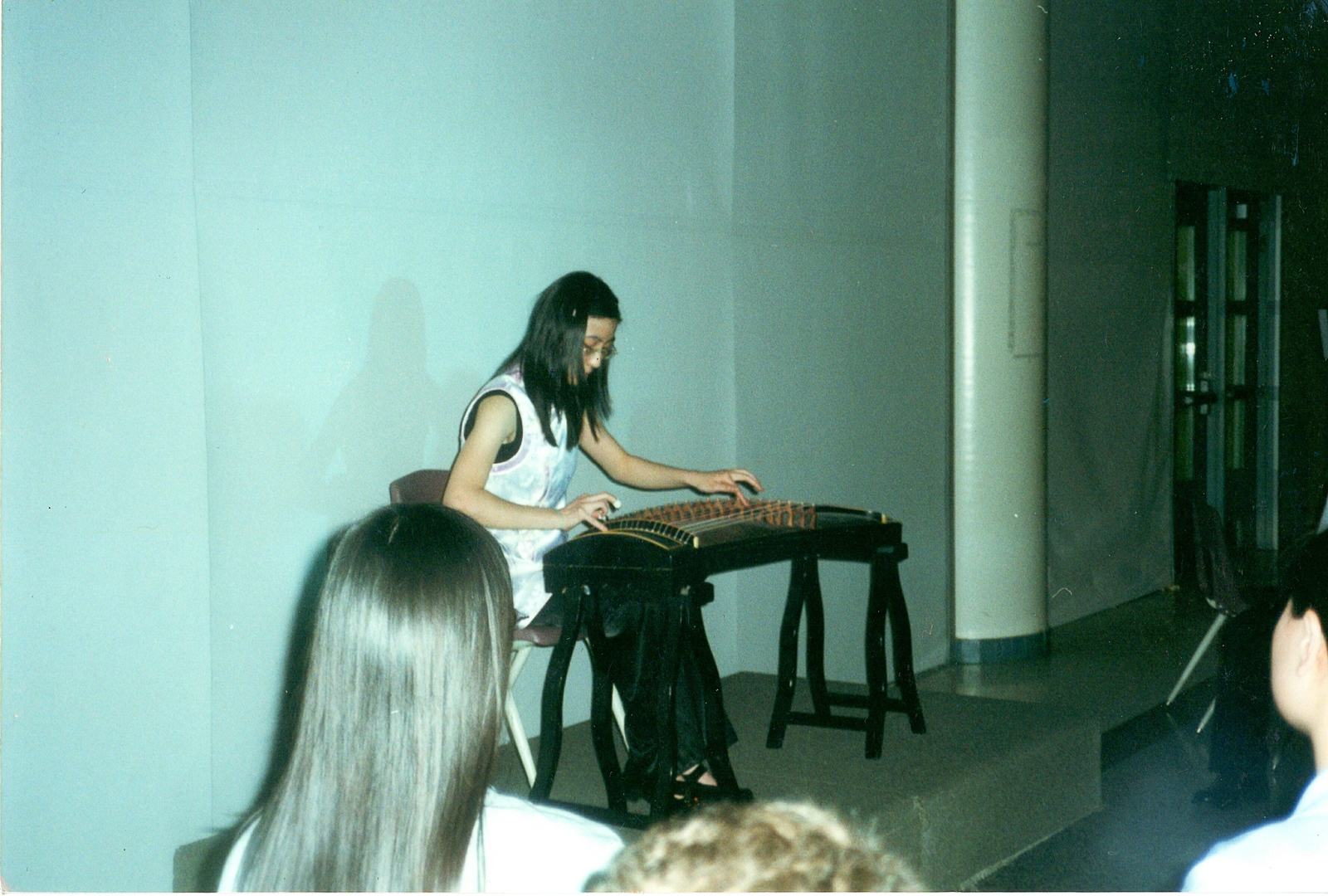 Isa Lee playing her guzheng at Middlefield Collegiate Institute. Isa Lee’s technical exam for Chinese instruments
Isa Lee playing her guzheng at Middlefield Collegiate Institute. Isa Lee’s technical exam for Chinese instruments
Today, youth continue their love of music, participating in school bands, community groups, and in private lessons. Listen to the Junior Choir from Nokiidaa Public School play "Little Silver Moon Boat." This traditional Chinese ballad is written using the traditional Chinese pentatonic scale gōng 宫, shāng 商, jué 角, zhǐ 徵 and yǔ 羽. Its lyrics use a metaphor of the moon as a boat that travels swiftly among the stars to the west up in the sky. In this recording, the students are singing while some are supporting the vocals with an Orff accompaniment on the Xylophones.
The Art of Tailoring
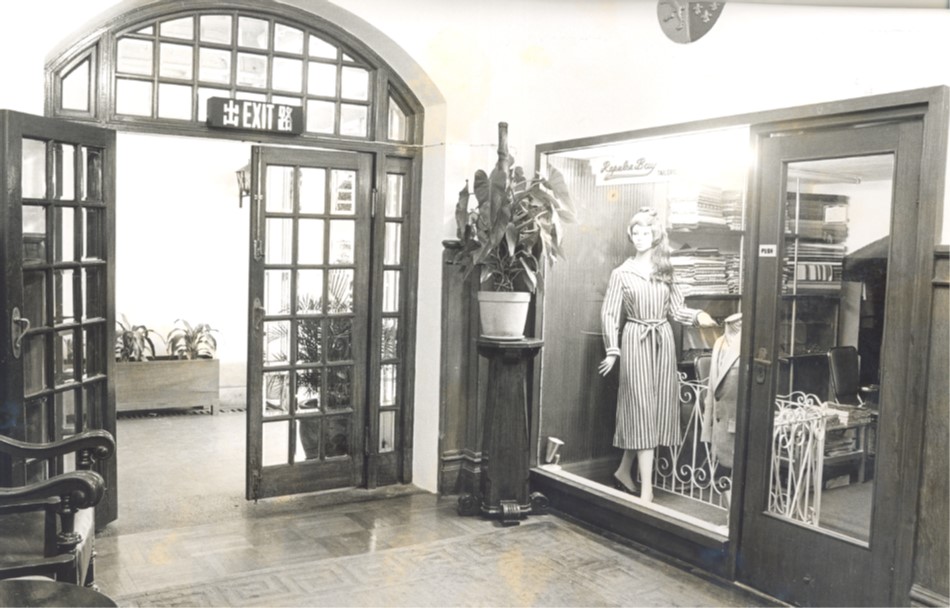 A photograph of the Sung Family’s tailoring business, Repulse Bay Tailors, in its original Hong Kong location. The Sungs moved the family tailoring business with them to Markham in 1996.
A photograph of the Sung Family’s tailoring business, Repulse Bay Tailors, in its original Hong Kong location. The Sungs moved the family tailoring business with them to Markham in 1996.
When making the decision to come to Canada, Connie and Tommy Sung chose to bring their tailoring skills. The Sung family came to Canada from Hong Kong in 1996 and brought their tailoring skills and business to Markham. In Hong Kong, they served the wealthy community of Repulse Bay in Hong Kong. The customers they served wanted Western tailoring skills, with many of their customers expatriates from Europe and North America.
When the Sung family arrived in Markham, they found there was no market for hand-made traditional Western-style clothing. After struggling for many years to find patrons who recognized their skills, they shifted from making Western-style clothes to making cheongsam (Cantonese for “long gown,” a Chinese-style dress, typically tight-fitting with high side slits) for the large Chinese Canadian population in the region.
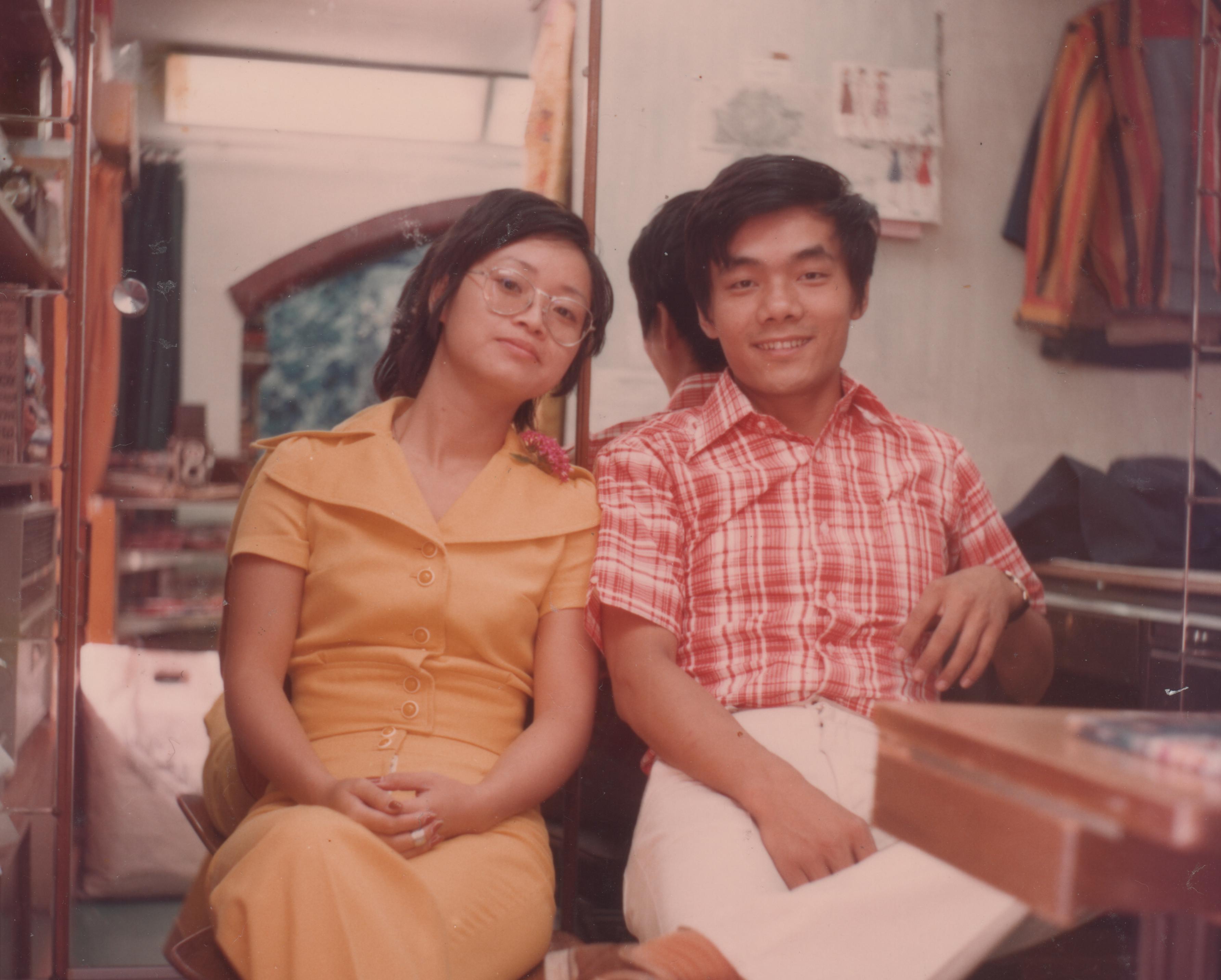 Tommy and Connie, c. 1971. On loan from the Sung Family
Tommy and Connie, c. 1971. On loan from the Sung Family
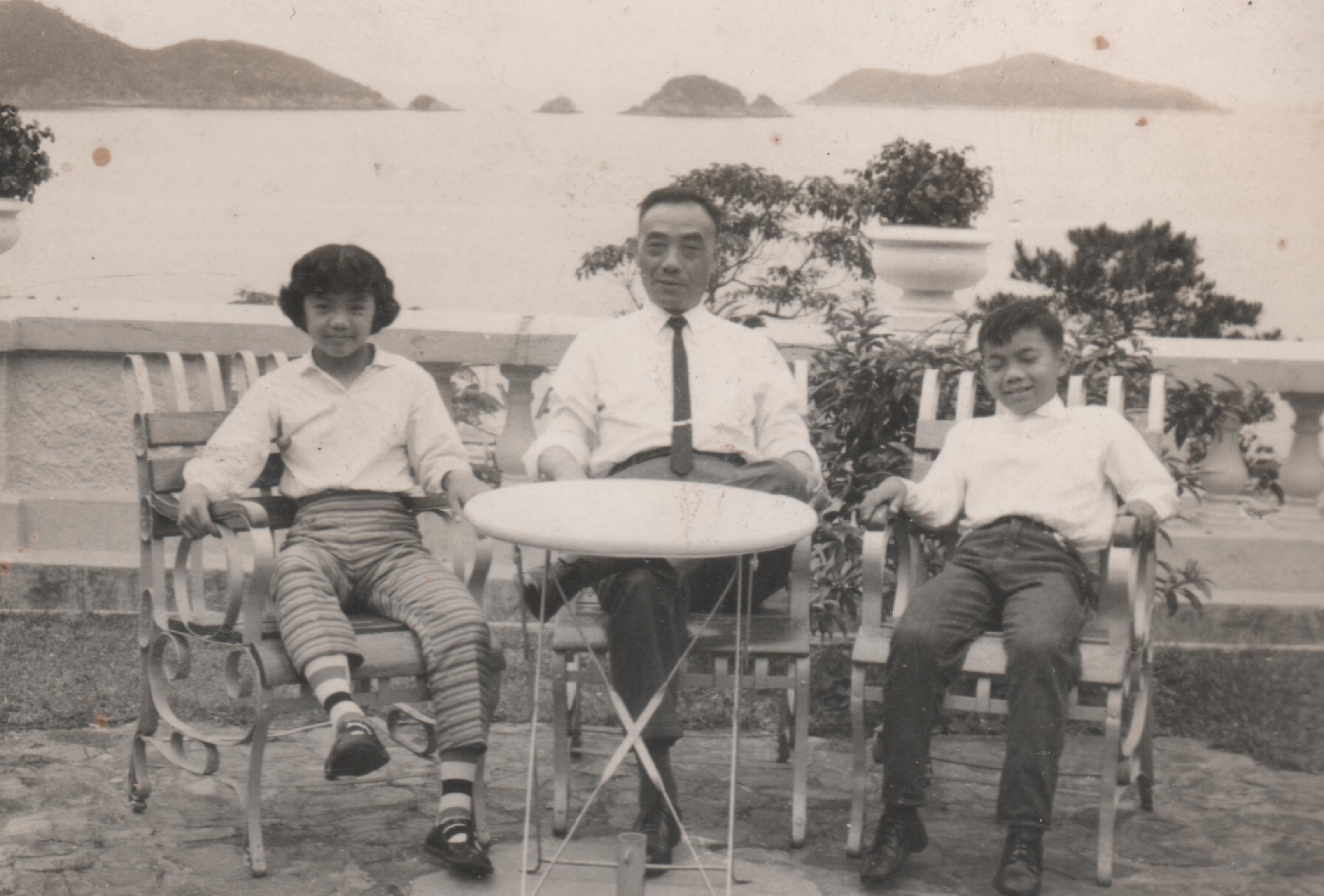 Tommy, father, sister at Repulse Bay, late 1950s
Tommy, father, sister at Repulse Bay, late 1950s
Take a look at the Sung’s tailoring business and some of their cheongsam designs (photos are all courtesy of the Sung family):
|
|
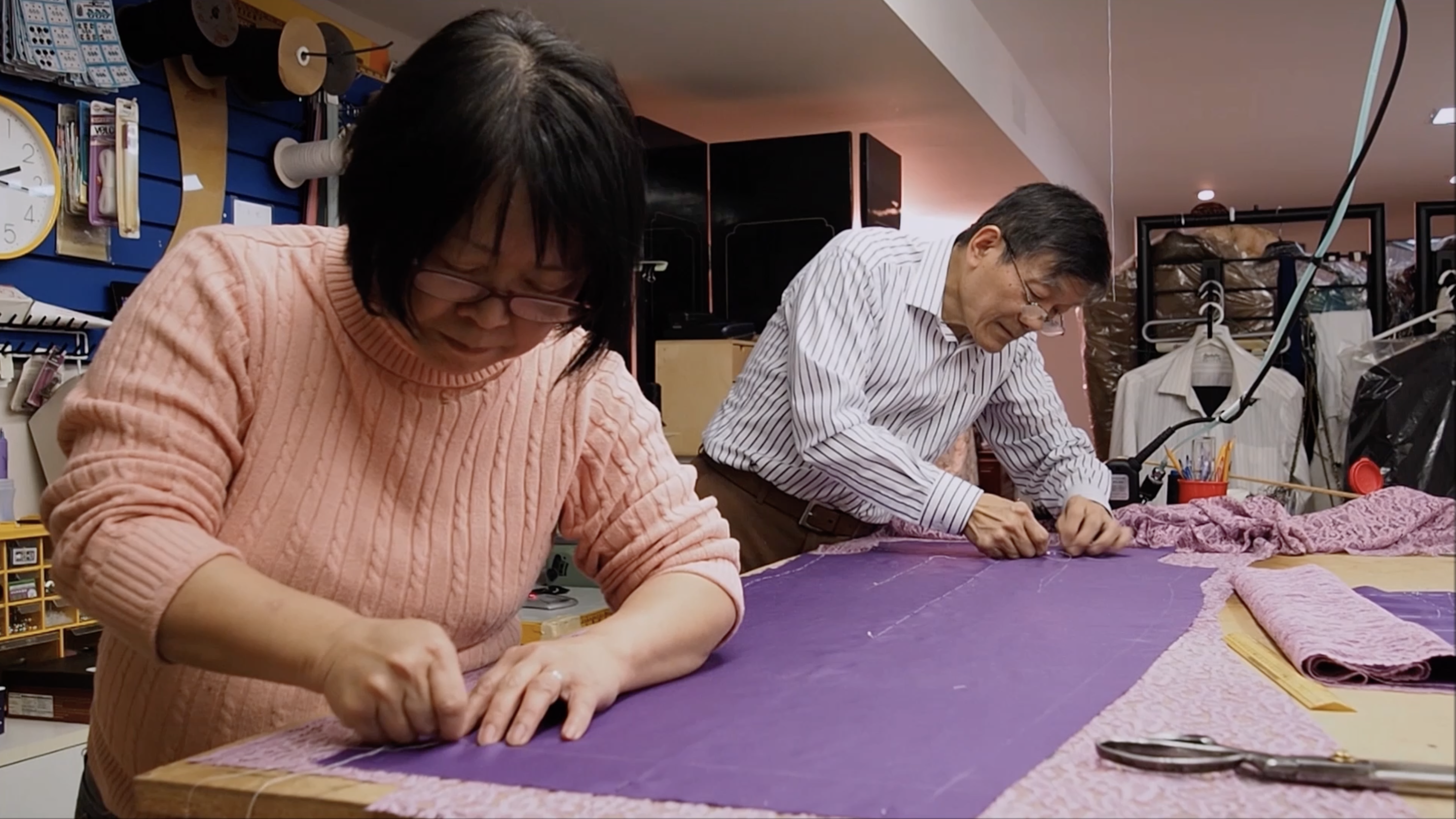 Tommy working in his tailor shop.
Tommy working in his tailor shop.
|
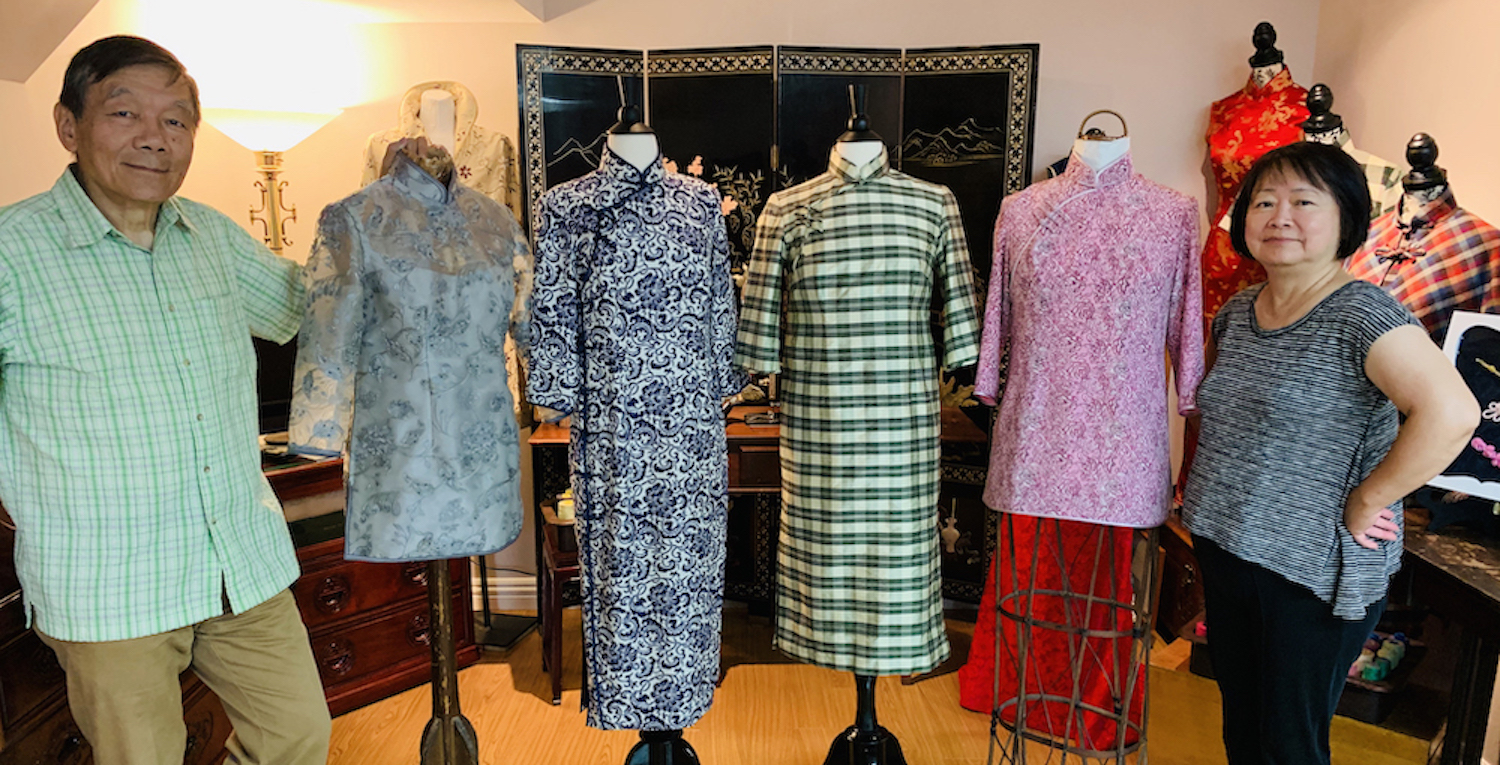 Tommy and Connie with their designs. Courtesy of Sung family.
Tommy and Connie with their designs. Courtesy of Sung family.
To celebrate his parent’s artistic abilities in a slowly disappearing craft, in 2019 Connie and Tommy’s son Alfred Sung released the full-length documentary “The Last Stitch.” This story follows the Sung family as they move from Shanghai to Hong Kong and then Toronto and Markham. Created specifically for the Standing in the Doorway exhibition, this short video clip depicts the journey of the Sung family from Hong Kong to Markham.

Bringing Chinese Culture to Canada
Chinese Canadians have adapted and in many ways adopted Canadian culture and ways of life. They learned English, made new friends in Canada, and established businesses.
Diaspora communities in Canada enrich our society with a variety of cultural practices, including distinct foods, languages, arts, sports, trades, and celebrations. Members of the community also visit local museums, art galleries and community celebrations. One of Allan Tam’s favourite places to visit locally is Markham Museum!
> Take a listen here.
Through people's efforts to preserve what was important to them, a distinctly Chinese Canadian culture has emerged. Some of its most recognizable features include Chinese malls, dragon boat racing, Chinese language schools, and Chinese Canadian dishes.
Dragon Boat Racing
Dragon boat racing is a sport deeply rooted in Chinese culture. According to Ancient Chinese legend, guardian dragons lived in underwater palaces in every river and lake. While mostly well-meaning protectors, the dragons could cause floods or droughts when angry. Dragon boat races honoured these protectors and were thought to bring prosperity and bountiful crops. Dragon boat festivals are held on the fifth day of the fifth lunar month. Prior to dragon boat races, the dragons are awakened through the tradition of “eye-dotting.” This ritual of dabbing red paint on the dragon’s eyes awakens its spirit, drives away the evil and blesses the competitors.
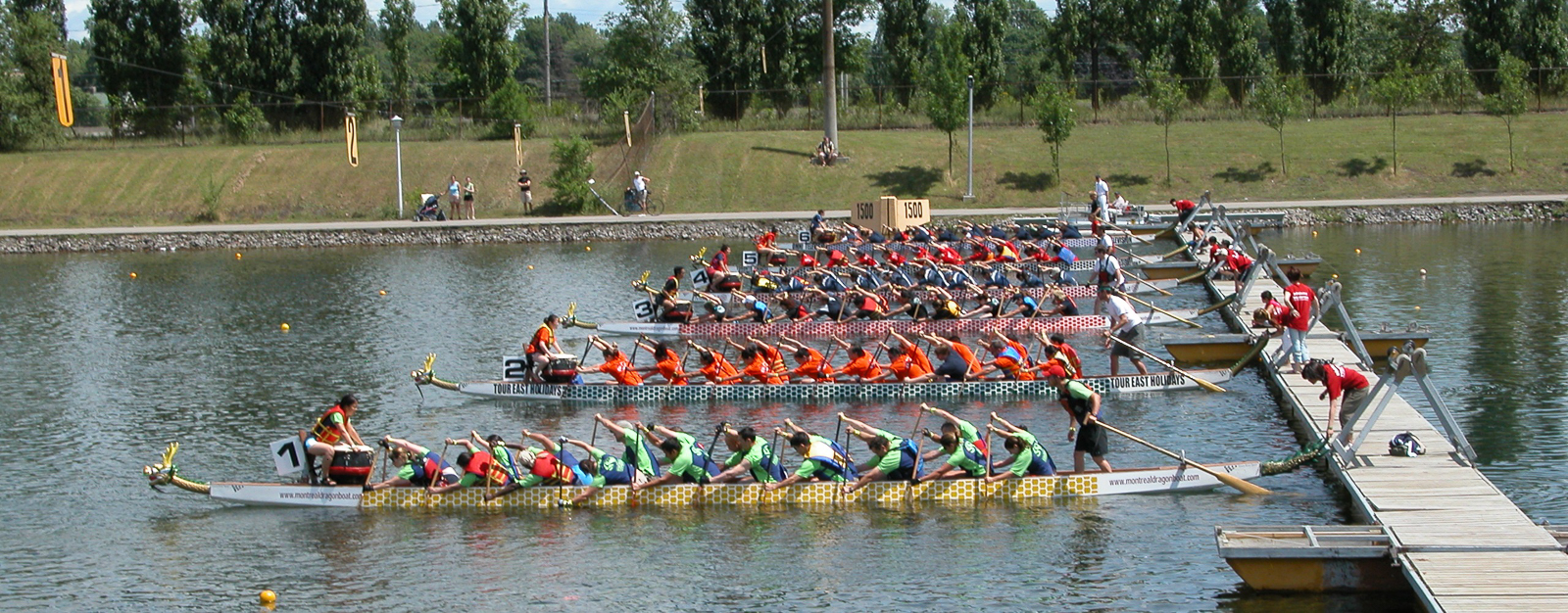 Dragon boat racers in the race ready position. Courtesy of Arlene Chan.
Dragon boat racers in the race ready position. Courtesy of Arlene Chan.
Today, dragon boat racing is not only a popular team sport in Canada but also a unifying activity that brings together people from various cultures and places, often to raise money for charitable causes. The Toronto International Dragon Boat Race Festival has taken place on Toronto Island since its inception in 1989. Today the Festival hosts over 5,000 paddlers at its annual event. Community dragon boat races are held across the Greater Toronto Area, including Pickering where YRDSB students often practice and race.
 Gold and bronze medals won by the Markville Secondary School dragon boat racing team, Markville Dragon Boat Team. Courtesy of Markville Secondary School.
Gold and bronze medals won by the Markville Secondary School dragon boat racing team, Markville Dragon Boat Team. Courtesy of Markville Secondary School.
Here in York Region, both Pierre Elliott Trudeau High School and Markville Secondary School have paddling teams. Since the early 2010s, many students with no prior experience have had the opportunity to try the sport. Others have previous paddling experience when they lived in Hong Kong. Markville student Mathew Spataro joined the team, “because it looked like a fun sport to play with my friends. I also thought it would be a challenging sport where I could push myself and make new friends with my teammates.” Given the sport’s health benefits and positive community spirit it fosters, many participants choose to continue paddling even after completing high school.
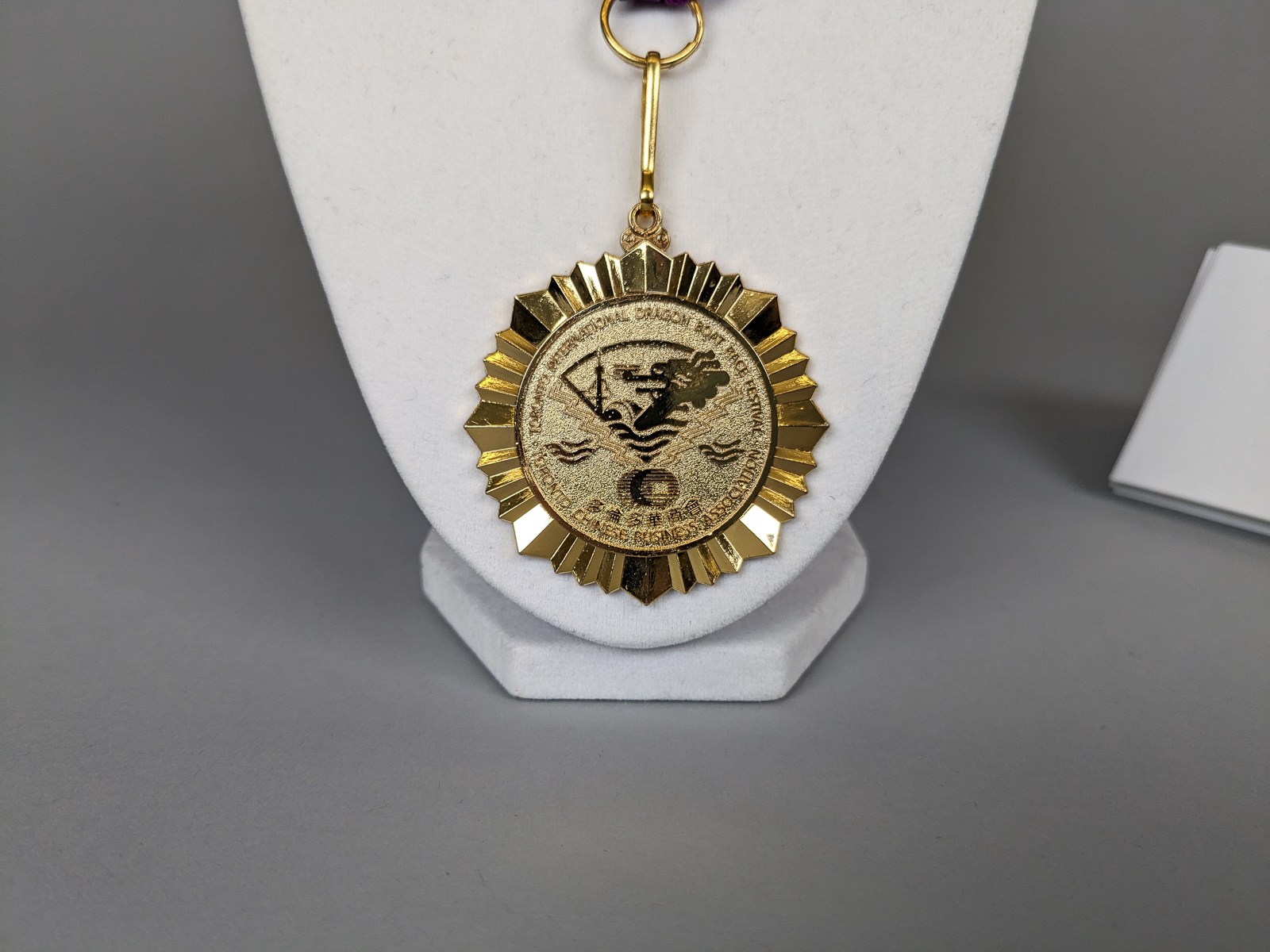 2016 Gold medal won by the Pierre Elliott Trudeau High School dragon boat racing team, TruDragon Dragon Boat Team at the Toronto International Dragon Boat Racing Festival. Courtesy of Pierre Elliott Trudeau High School.
2016 Gold medal won by the Pierre Elliott Trudeau High School dragon boat racing team, TruDragon Dragon Boat Team at the Toronto International Dragon Boat Racing Festival. Courtesy of Pierre Elliott Trudeau High School.
“Many of [my students] continue on with their university dragon boat teams. One year at the Toronto Island festival, four of our alumni paddlers wearing four different university jerseys came back to our high school team camp to say hi. That was one of my best coaching moments.”
-Fanny Leung, Pierre Elliott Trudeau High School, TruDragons Coach

In the high school dragon boat scene, Markville Secondary School and Pierre Elliott Trudeau High School are rivals. These jerseys are worn by students. Often teams also have hoodies, since it can be quite cold after finishing a race. Courtesy of Markville Secondary School and Pierre Elliott Trudeau High School.
Toronto resident Arlene Chan, notable Chinese Canadian historian and author, was also an avid paddler. She participated recreationally, and then competitively from 2000 until 2015. Now retired from the sport, Arlene won a total of eight gold medals for the Canada National Women’s Dragon Boat team (over 50 category) in 2011 and 2013.
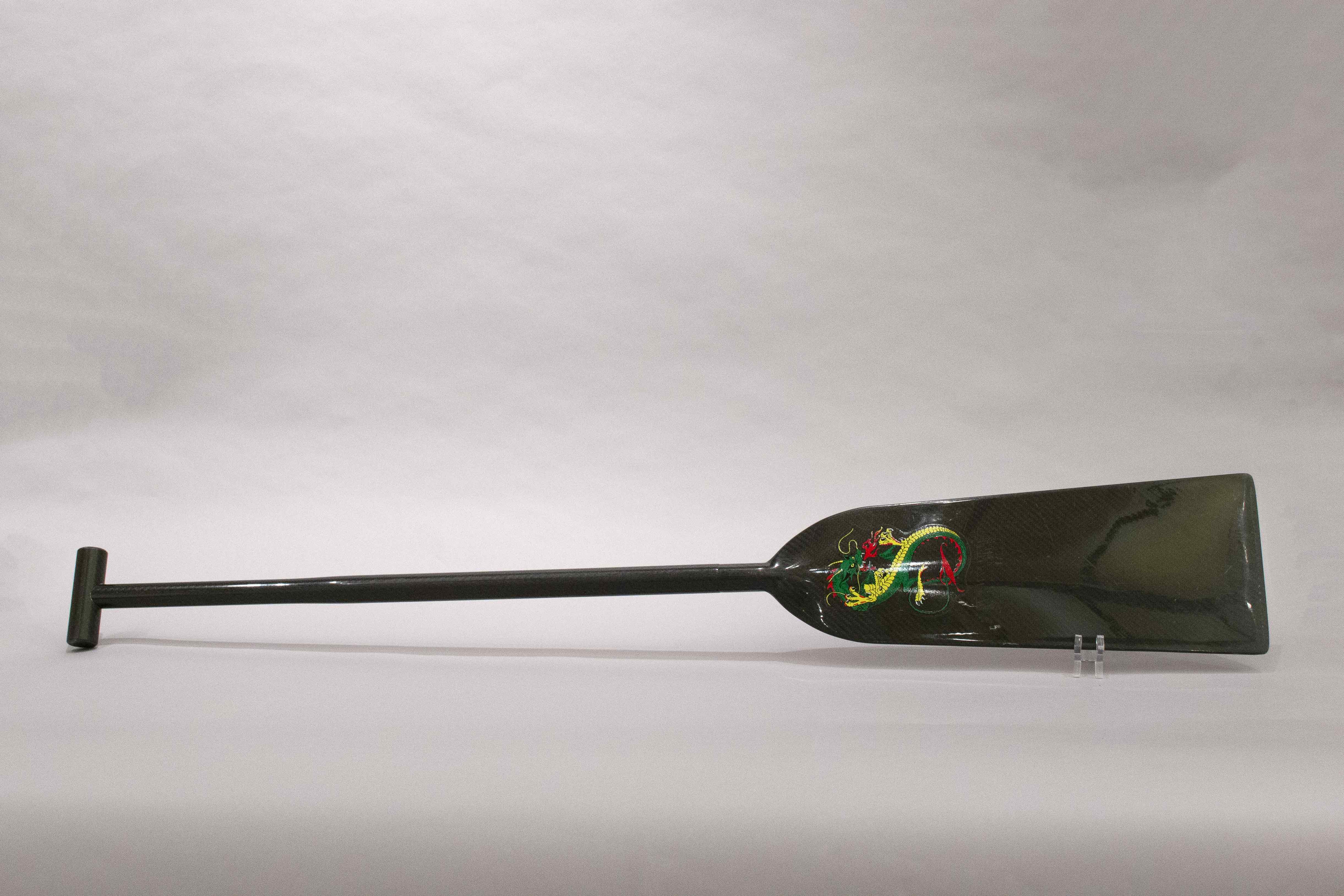 Official fibreglass dragon boat paddle decorated with a dragon. Used in three international competitions. On loan from Arlene Chan
Official fibreglass dragon boat paddle decorated with a dragon. Used in three international competitions. On loan from Arlene Chan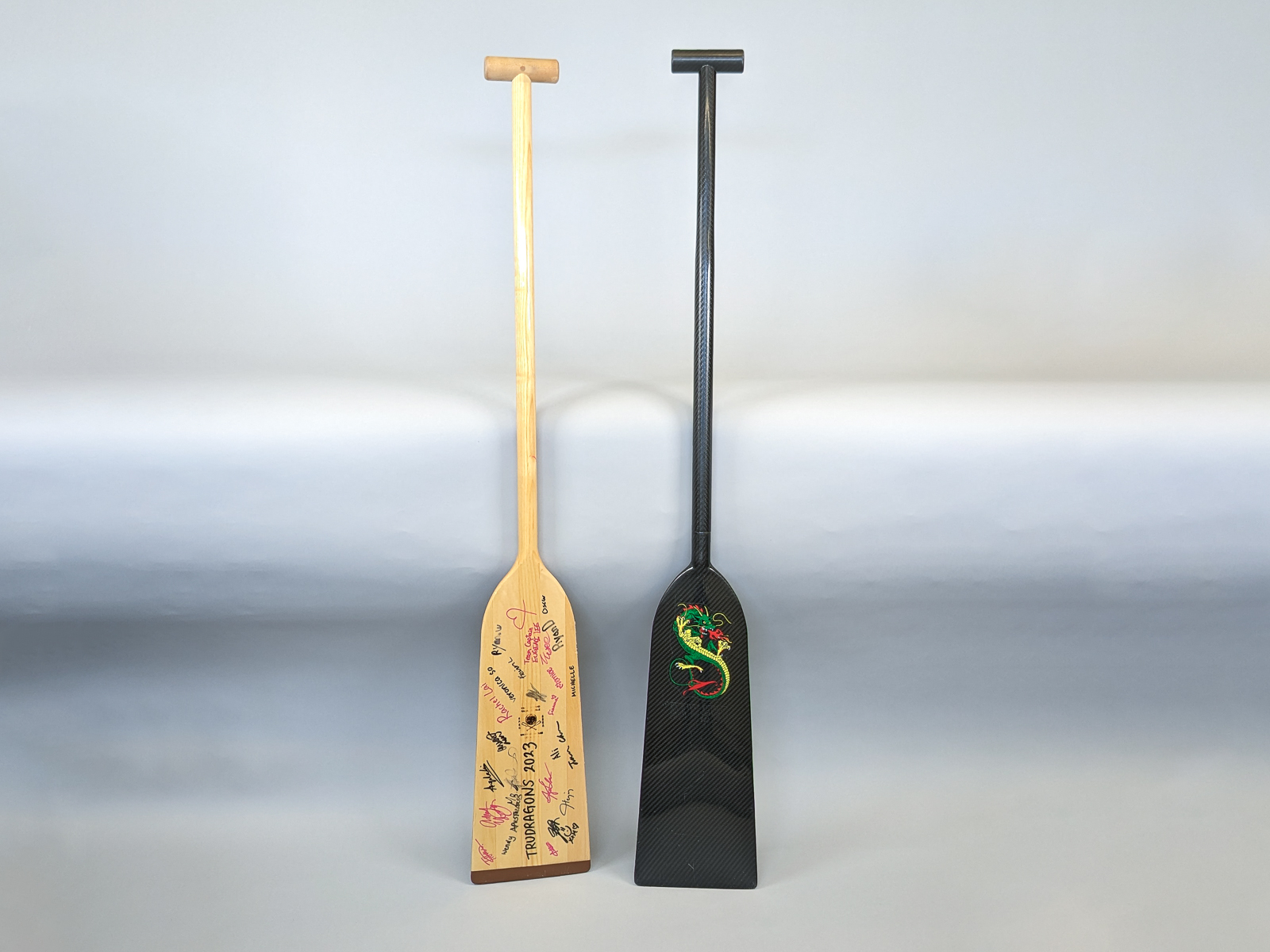
Dragon boat paddles from Pierre Elliott Trudeau High School and Arlene Chan. To be cost effective, high schools have wooden paddles for racing. Professionals will purchase carbon fibre options, which are more light weight.
Courtesy of Pierre Elliott Trudeau High School and Arlene Chan.
Sports at the Pan Am Centre
The XVII Pan American and Para Pan American Games, known as the 2015 Toronto games, were hosted by 18 communities in the Greater Toronto Area. Markham’s Pan Am Centre was one of ten new facilities purpose built for the games. Badminton, Table Tennis, Water polo and Golf were hosted in the city.
Table Tennis (also known as ping pong) and Badminton are popular sports within the Chinese community. As a legacy for the community, the Pan Am Centre is an important training facility for local and national athletes, international competitions as well as a training centre for the students of Bill Crothers Secondary School.
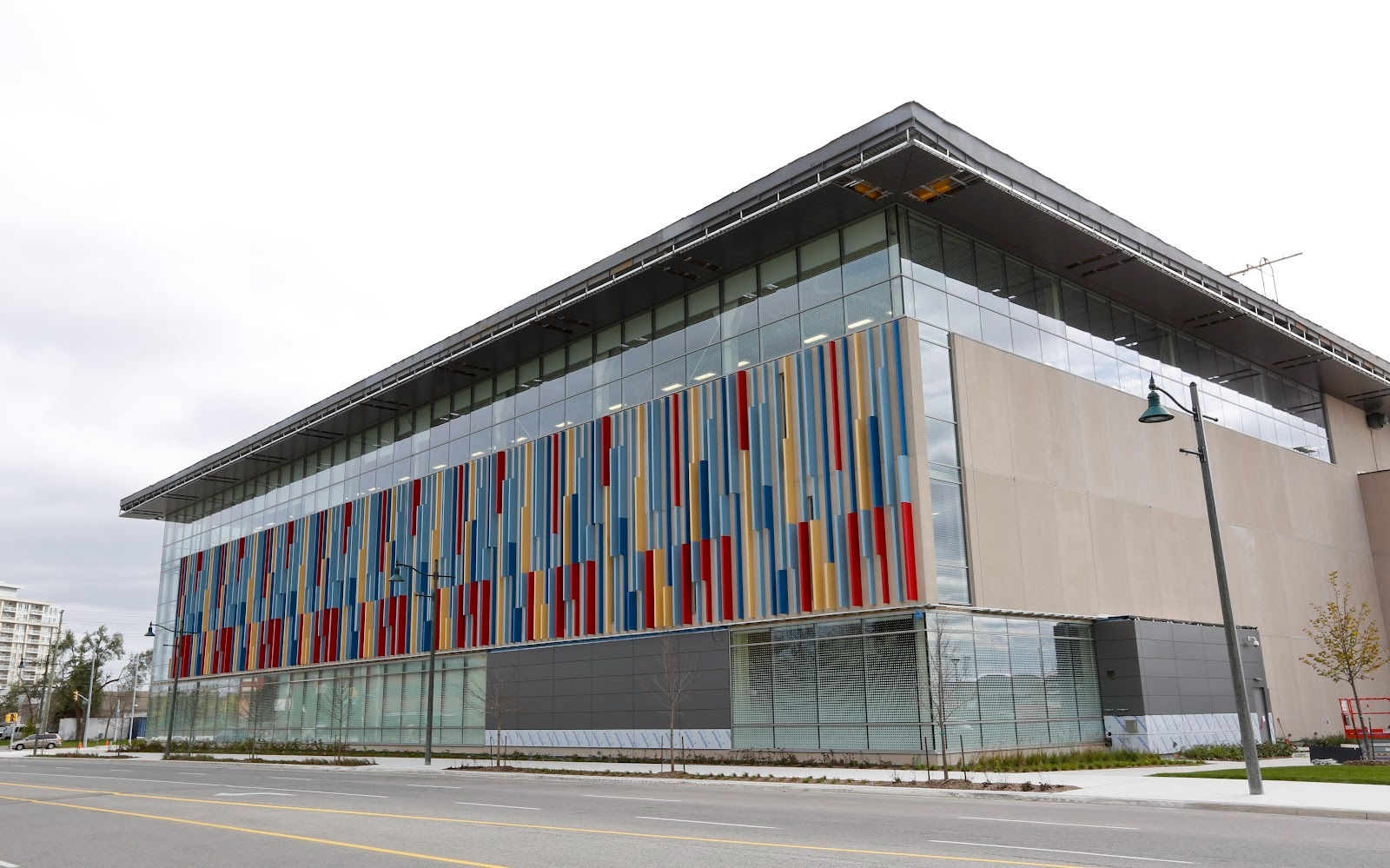
The Markham Pan Am Centre is a multi-purpose sport facility. Opened in November 2014, it was built for the 2015 Pan American and ParaPan American Games. (Markham Museum Collection.)
| Michelle Li |
|---|
|
Michelle Li is Canada’s leading female badminton player. Born in Hong Kong in 1991, Michelle attended Richmond Hill High School. She represented Canada at three Olympic Games and won gold medals at three Pan Am Games, including one played in Markham in 2015. The Markham Pan Am Centre is just one of the many facilities where she has played. Since advancing to the international circuit, she has worked tirelessly to alleviate the disparity in national funding for hers and other ‘Asian’ sports. Michelle often travels to tournaments without the support of technical advisors and teammates that other international players take for granted. In 2023, Michelle continues to play at the professional level and lives in Markham. 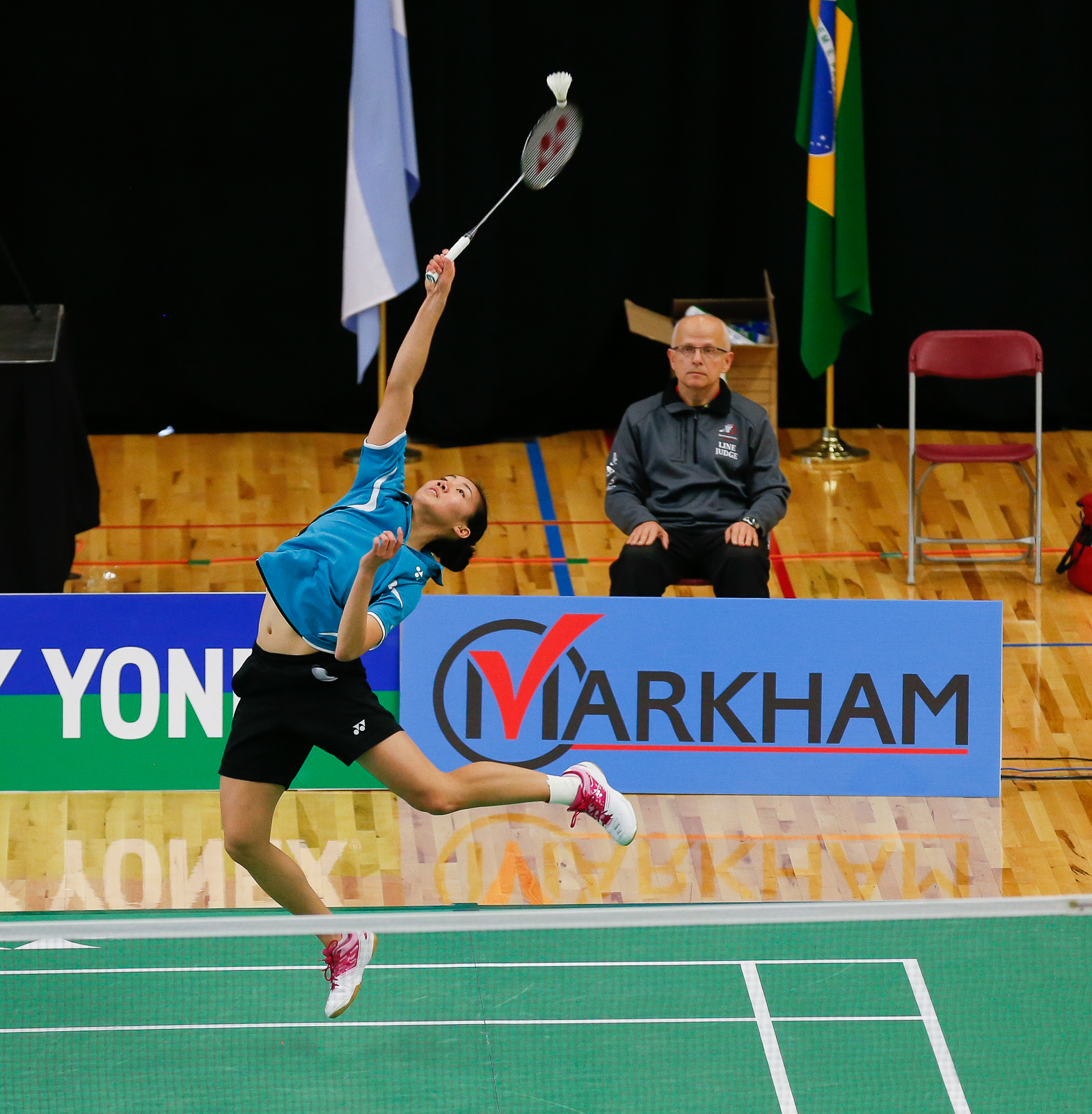 Michelle Li competing during the 2015 Pan Am games. Courtesy of the City of Markham.
Michelle Li competing during the 2015 Pan Am games. Courtesy of the City of Markham.
|
Did you know the mascot of the 2015 Pan / Para Pan Am Games was designed in Markham? Jenny Lee, Fiona Hung, Michelle Ing and Paige Kunihiro, Grade 8 students from Buttonville Public School created Pachi the porcupine. The design was selected in a national competition that received over 4,000 entries.
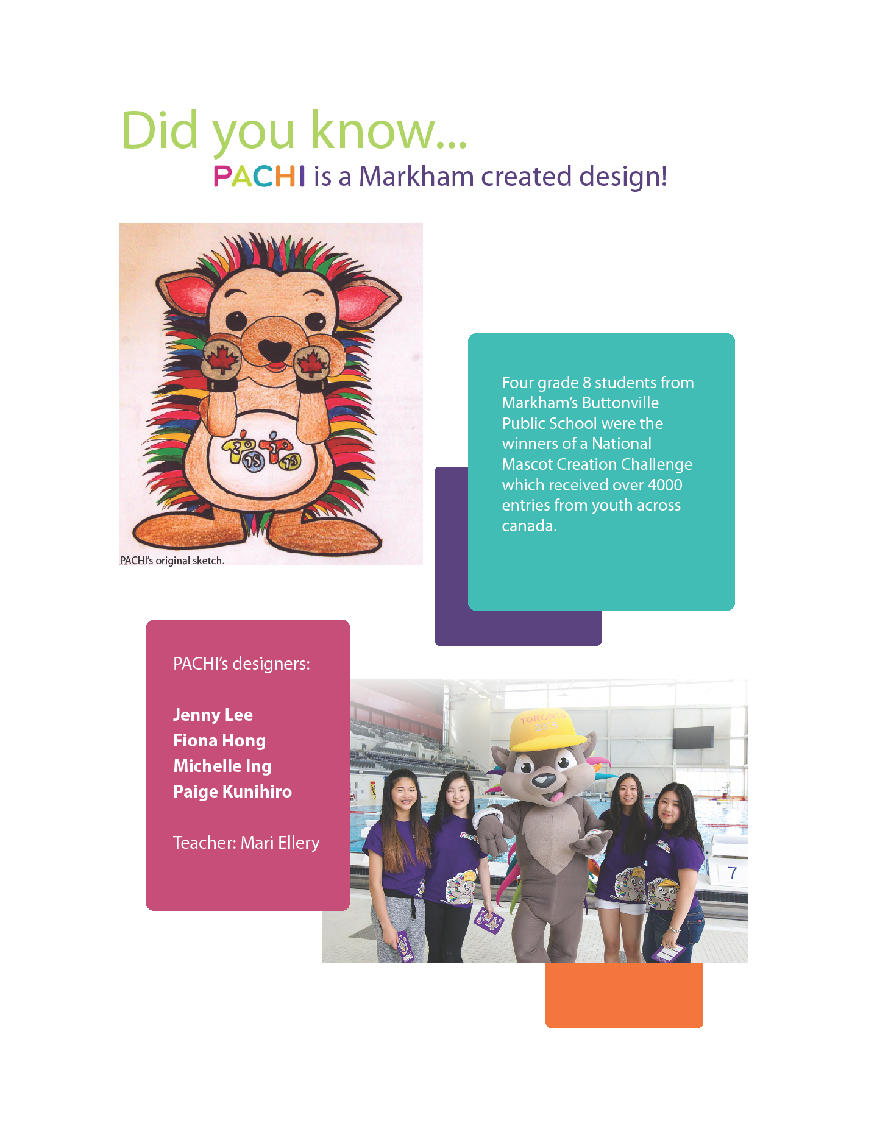
Chinese Food
Owning a restaurant or cafe has been a very popular business choice since the first arrival of Chinese immigrants. Chinese restaurants were some of the first Chinese-owned businesses in Canada, and their success provided support for their communities as a whole. Many menus adapted to the Western tastes, creating a unique “Canadian Chinese cuisine”. Chinese Canadian cuisine is a blend of traditional Chinese recipes, Canadian ingredients and cooking techniques. Carrots and celery are not common in authentic Chinese dishes, but are often included because of the accessibility of these vegetables in Canada. As the Chinese population grew, so too did the demand for a variety of cuisines and more traditional & authentic ingredients. Specialty grocery stores, such as T&T Supermarkets import many items. Restaurants and grocers also work with local growers in York Region, such as MaysRay Farm, to ensure a supply of fresh vegetables.
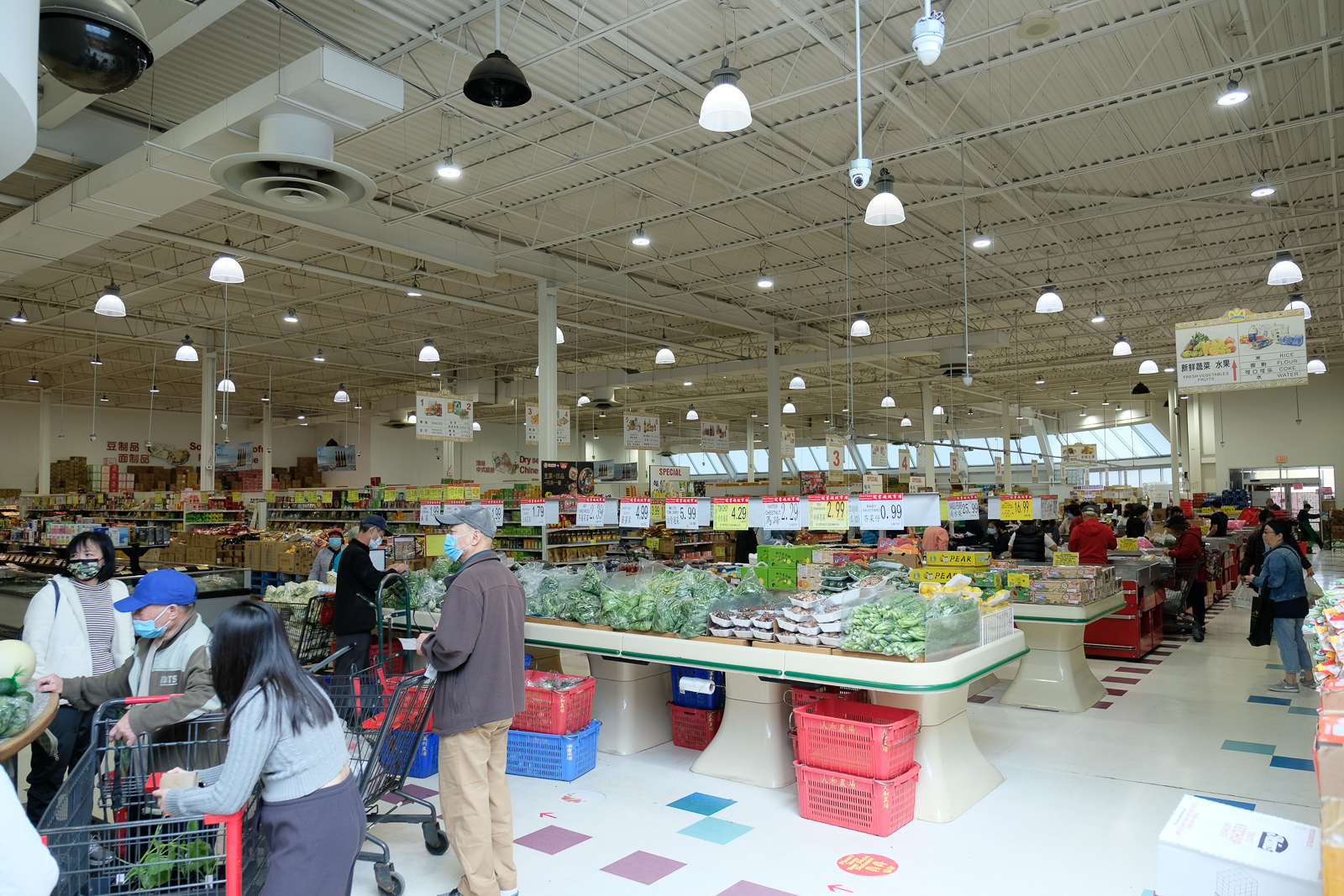 First Choice Supermarket, 2023. Courtesy of City of Markham.
First Choice Supermarket, 2023. Courtesy of City of Markham.
|
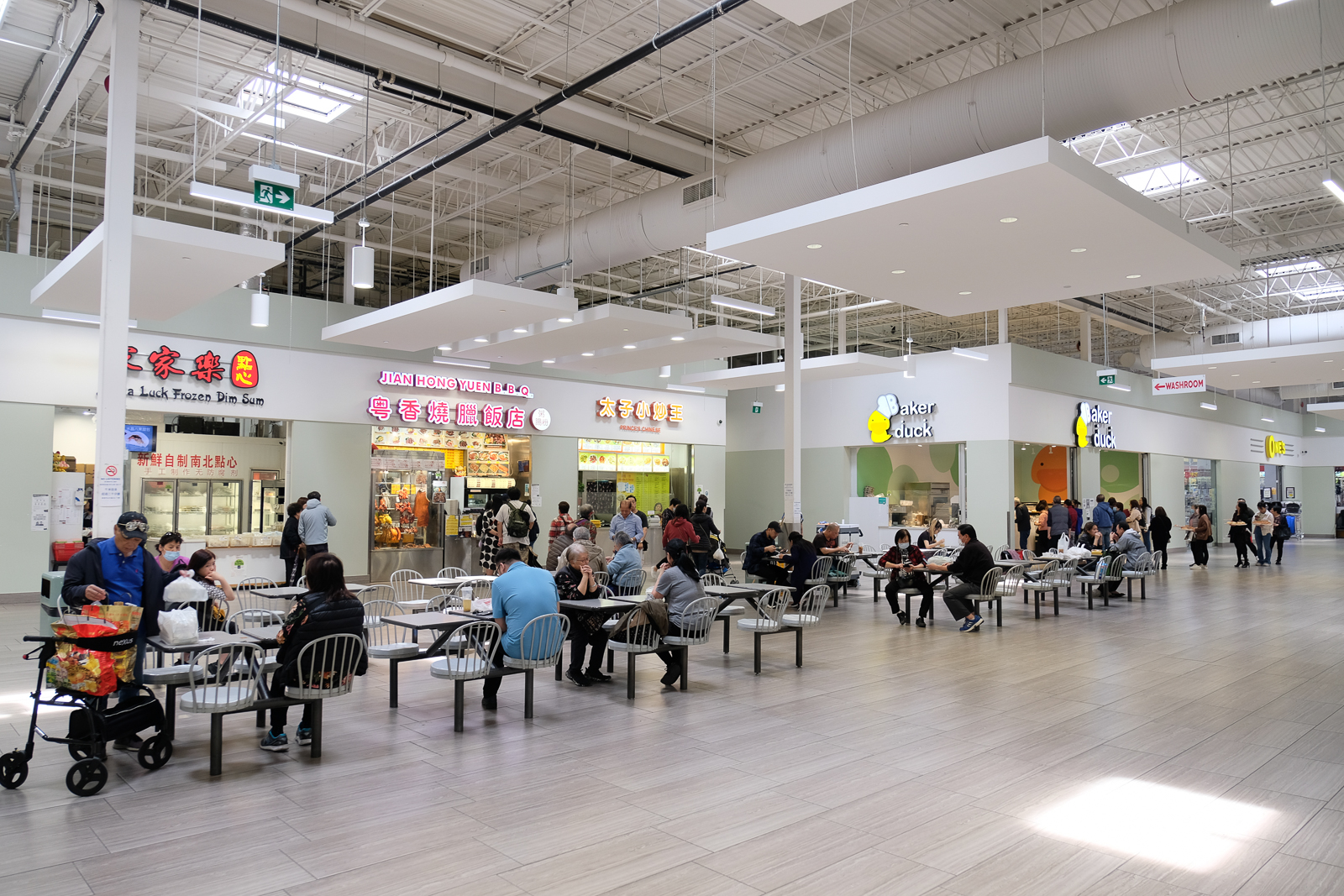 Denison Centre food court, 2023. Courtesy of City of Markham.
Denison Centre food court, 2023. Courtesy of City of Markham.
|
Water Caltrop is a type of water chestnut that matures in the fall. The seed is often called a bat nut because of the unique shape. As the word for bat (Fu) sounds similar to the word for good fortune, these unique treats appear in Chinese specialty markets in time for the Mid-Autumn Festival where they are a special treat.
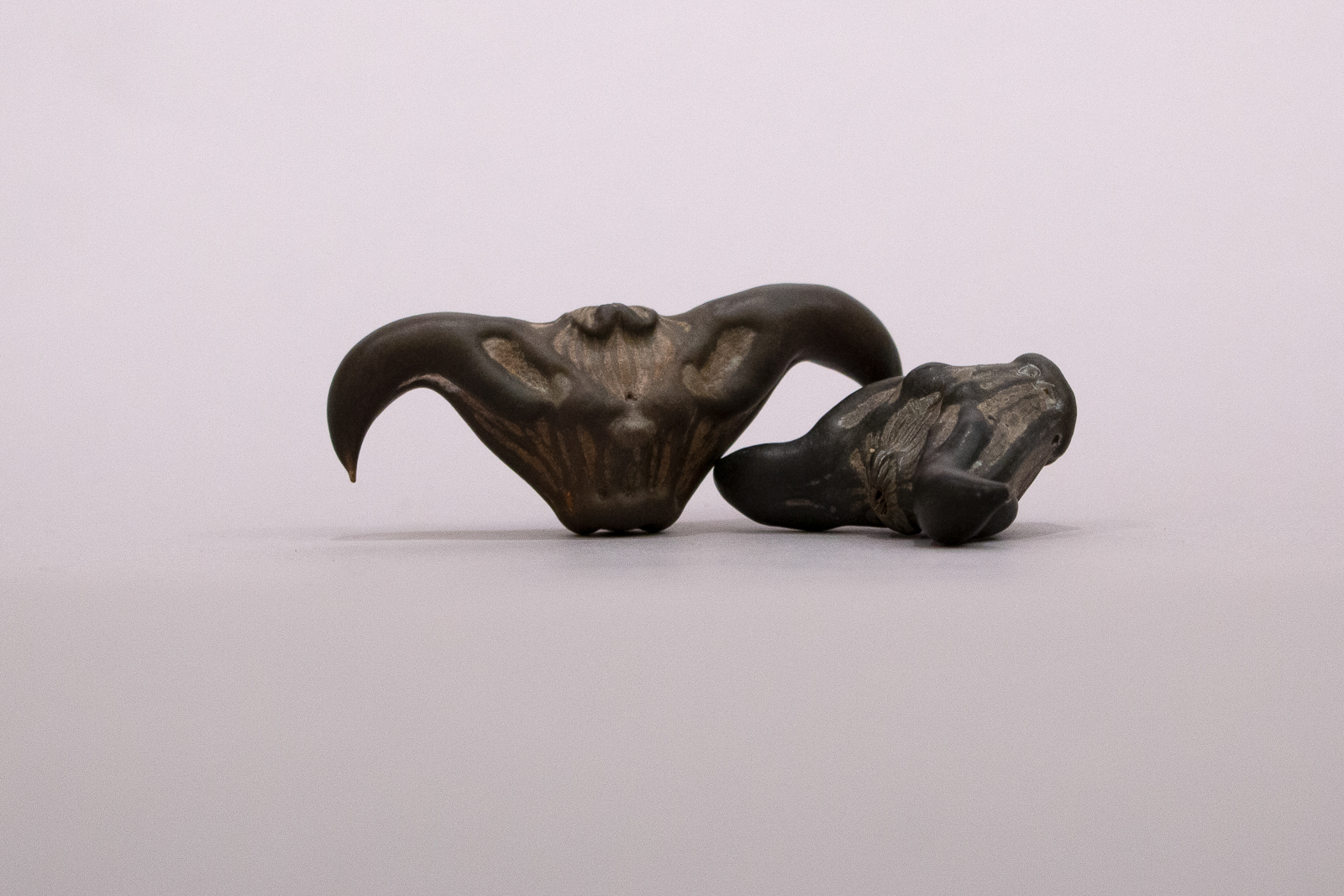 An example of dried bat nuts. Courtesy of Arlene Chan.
An example of dried bat nuts. Courtesy of Arlene Chan.
Did you know that Mandarin first opened in Brampton in 1979? Known for their extensive buffet offerings, today there are 29 locations across Ontario and the company employs over 3,000 people. Four of those locations are in York Region.
Did you know that Manchu Wok first opened in 1980 by Dr. Jack Lew as a small Peterborough restaurant? Today this Asian cuisine restaurant chain offers its quick service to hundreds of locations around the globe.
Did you know that the first Ontario T & T Supermarket location was in the Thornhill? It opened in The Promenade mall in 2002. Today T&T is has several locations across York Region, including Aurora, Markham, Richmond Hill and Vaughan.
 T&T grocery store. This is the Aurora location. 2023.
T&T grocery store. This is the Aurora location. 2023.
T & T is a Canadian supermarket chain that sells primarily Asian food. It was first started by Cindy Lee in 1993 in British Columbia. She wanted to be able to provide access to quality Asian produce. Cindy named the store after her daughters, Tina and Tiffany. It was purchased by Loblaw in 2009.
Today in York Region, Markham and Richmond Hill are known for some of the best authentic Chinese restaurants in Ontario. In fact, when people of Chinese descent crave a taste of “home,” they often visit one of the many Chinese restaurants in Markham.
Dim Sum is typically eaten as a snack with Chinese tea. There was a very early Chinese culinary tradition to eat light food before noon. This light food was called dim sum, which literally means "touching the heart," or "a little bit of the heart." Its pronunciation varies depending on which Chinese language was used. It can be additionally called “xiao chi” or “xiao cai” on some occasions in Mandarin.
The spelling "dim sum" comes from a way of pronouncing it in Cantonese. It also more specifically refers to a Cantonese food culture transformed from its ancient heritage. Going for dim sum is generally called "to drink morning tea," or "to enjoy morning tea" in Cantonese areas. Now in Canada, the types of dim sum can include seafood, meat, or vegetables. They are usually served as small dishes for breakfast, brunch, or lunch in Canada. People can steam or fry the food ingredients for making dim sum. It includes several types of bakery food. Take a look at the following examples of popular dim sum. The images were hand-painted and designed by Nokiidaa Public School family members.
Photo credit: Content created by students at Nokiidaa Public School, Max Lui as the group lead. Cliff Wong is the artist for all the hand-drawn images; Mina Wong is the graphic designer.
Chinese Opera
Chinese Opera is a traditional form of entertainment combining music and theatre. Early Chinese immigrants to Canada brought with them a passion for this art form. Similar to many types of western theatre, roles can be played by men or women. For the largely bachelor communities that existed prior to 1947, this flexibility proved very helpful when casting productions. Cantonese style Opera is one of the most popular variations in Chinese communities around the world and is performed in York Region. This distinctive form of opera involves music, singing, martial arts, acrobatics and theatre.
 Example of a head dress. Called "The Golden Hermit," this head dress came from Hong Kong. Courtesy of Starlight Chinese Opera Performing Arts Centre.
Example of a head dress. Called "The Golden Hermit," this head dress came from Hong Kong. Courtesy of Starlight Chinese Opera Performing Arts Centre.
|
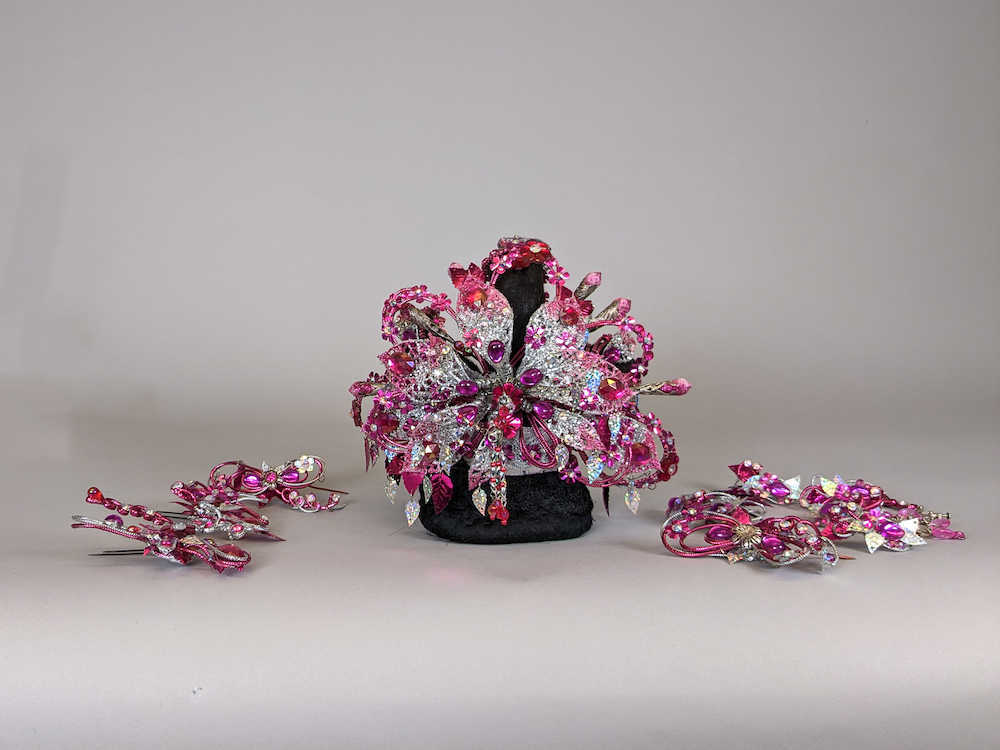 Example of a head dress and accompanying hair clips. All these items have been made locally in the GTA. Courtesy of Starlight Chinese Opera Performing Arts Centre.
Example of a head dress and accompanying hair clips. All these items have been made locally in the GTA. Courtesy of Starlight Chinese Opera Performing Arts Centre.
|
Watch this short video to hear the sounds, see the unique costumes, and watch the grateful movements of performers from the Starlight Chinese Opera Performing Arts Centre.
Located in Richmond Hill, Starlight Chinese Opera Performing Arts Centre is both a performing company and a training centre for adults and youth. Director Alice Chan is traditionally trained and has presented programs with professional performers from Hong Kong. She also has adapted the opera for the unique circumstances of Canada, by modifying the costumes, scripts and other features of the performance creating a unique and contemporary style.
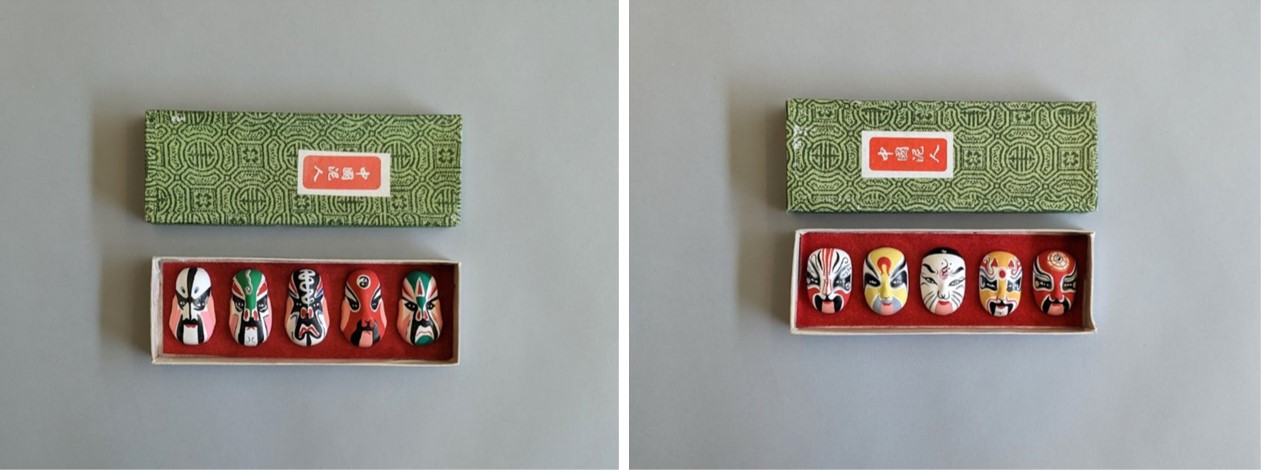
In Chinese opera, masks are used to represent the different characters. The colours and patterns symbolise personality traits, such as red for loyalty and courage, or white for mistrust and cunning behaviour. In Cantonese opera, instead of masks, paint is applied directly on the face.
Chinese School
Beyond preserving the tastes and flavours of home, Chinese Canadians have also endeavoured to preserve their history and culture.
 Examples of dictionaries used for translation. Courtesy of Jadas Lau.
Examples of dictionaries used for translation. Courtesy of Jadas Lau.
Working in collaboration with the Chinese community, the YRDSB’s Indigenous Languages and International Languages program delivers Chinese language and cultural education to families in York Region. This program is funded by the Ontario Ministry of Education to help preserve a multitude of cultures and languages, including Mandarin and Cantonese. The YRDSB has over 13,000 students enrolled across 13 sites in the Indigenous Languages and International Languages program. Take an opportunity to listen to Jadas Lau, who is the Indigenous Languages and International Languages program site administrator. All the Friday night classes that she supports are all Chinese speaking. In addition to her work at Nokiidaa Public School and the ILIL program, she still finds time to stay engaged with the community through volunteer work.

Preserving Chinese culture and heritage is important to many Chinese Canadians. Participation in cultural events such as Lunar New Year, the Moon Festival and the Dragon Boat Festival help to maintain an important historical connection to one’s heritage.
Lunar New Year Celebrations
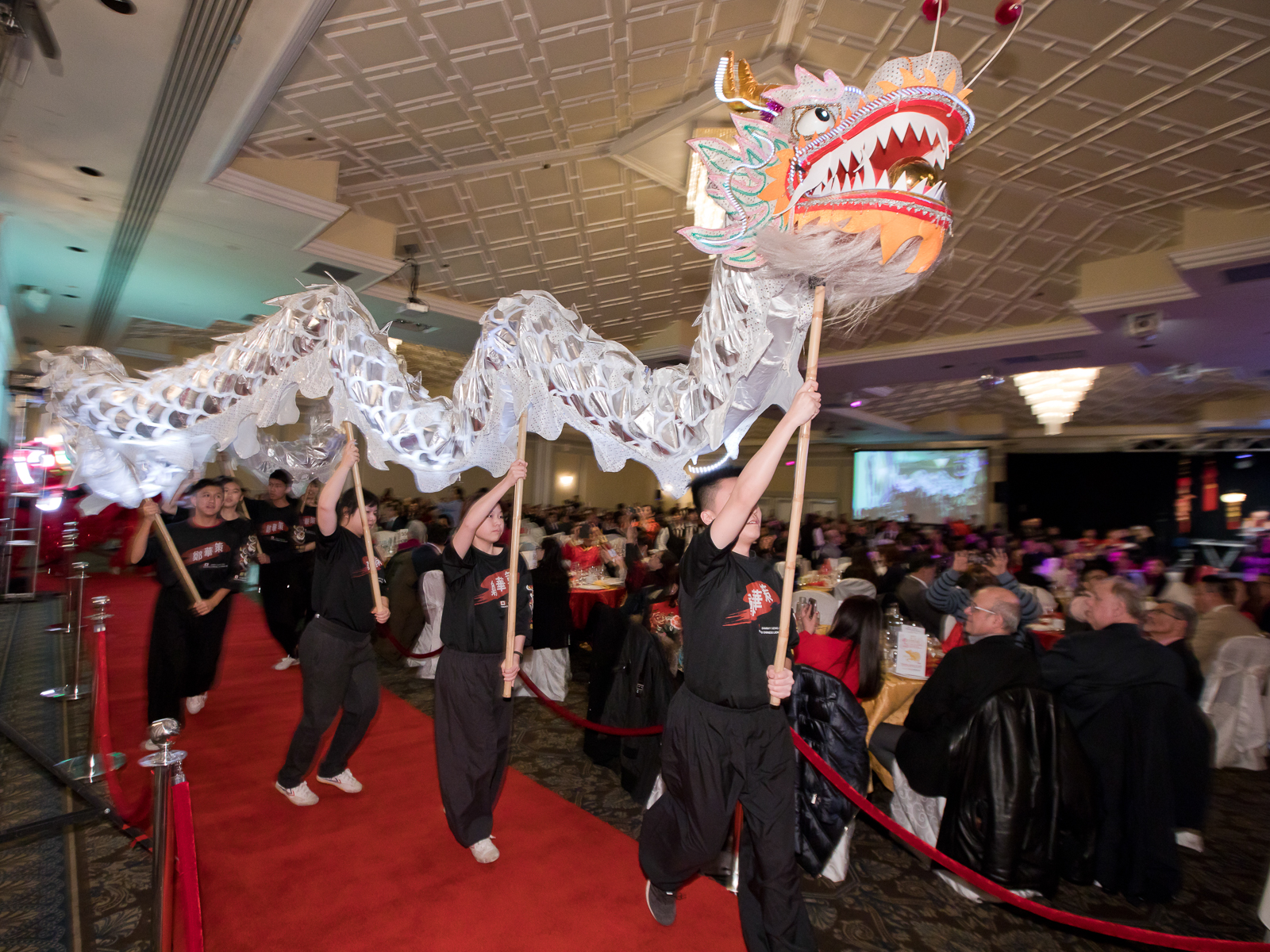 Dragon dancers participating in a Lunar New Year celebration in Markham, 2020. Courtesy of the City of Markham
Dragon dancers participating in a Lunar New Year celebration in Markham, 2020. Courtesy of the City of Markham
This global cultural celebration marks the first new moon of the lunar calendar. Lasting for 15 days, Lunar New Year is a very popular family festival celebrated in China and many other Asian countries (South Korea, Vietnam, Indonesia and Malaysia are a few examples). Also known as the Spring Festival, it is the most important festival in China. Millions of people around the globe travel to celebrate with their families.
Each year is associated with one of the 12 zodiac animals. For instance, in the Chinese zodiac, 2023 is the year of the rabbit while 2024 will be the year of the dragon. Some countries have different animals associated with their country’s zodiac calendar.
| How do you wish someone a “Happy Lunar New Year”? |
|---|
|
In Mandarin, "Xīnnián kuàilè" (新年快乐). The literal translation of this is 'New Year Happiness' or ‘Happiness for the New Year’. In Cantonese: "Gong hei fat choy" (恭喜发财). This means 'Wishing you happiness and prosperity.' |
Here in York Region, it is also a very popular festival. Families often gather at homes and restaurants, eating meals together and celebrating the arrival of a new year. People will clean their homes, put up decorations like lanterns and wear their best cultural Chinese clothing. Many traditions like setting off firecrackers or fireworks and watching lion or dragon dances are a way to scare away evil and bad luck. Malls across York Region often offer celebrations with lion dances, martial arts performances, calligraphy demonstration, dance, opera and music. It brings many residents comfort, that even if family members are not in the same country, they are still celebrating Lunar New Year together. Listen to community member Cindy Keung speak about how she enjoys celebrating this event.
The colour red is a popular colour for this festival. It symbolizes energy, happiness and good luck in Chinese tradition. On New Year’s day, family members exchange envelopes containing new money or “lucky money”. This is to symbolize good wishes and luck for the year ahead. Take a look at a few examples of red envelopes:
 Caption Assorted red envelopes or red packets. Courtesy of Jadas Lau.
Caption Assorted red envelopes or red packets. Courtesy of Jadas Lau.
In many YRDSB schools, students and staff will showcase how their family celebrates the Lunar New Year. They will make crafts and decorations, and have discussions about the cultural heritage traditions they celebrate at home during this time of year.
 Examples of crafts and lanterns used in Lunar New Year celebrations. Courtesy of Jadas Lau.
Examples of crafts and lanterns used in Lunar New Year celebrations. Courtesy of Jadas Lau.
Listen to Minister of Provincial Parliament Billy Pang and local resident Cindy Keung both speak about the importance of participating in cultural festivals and traditions in creating a sense of belonging and home.


Lion Dance
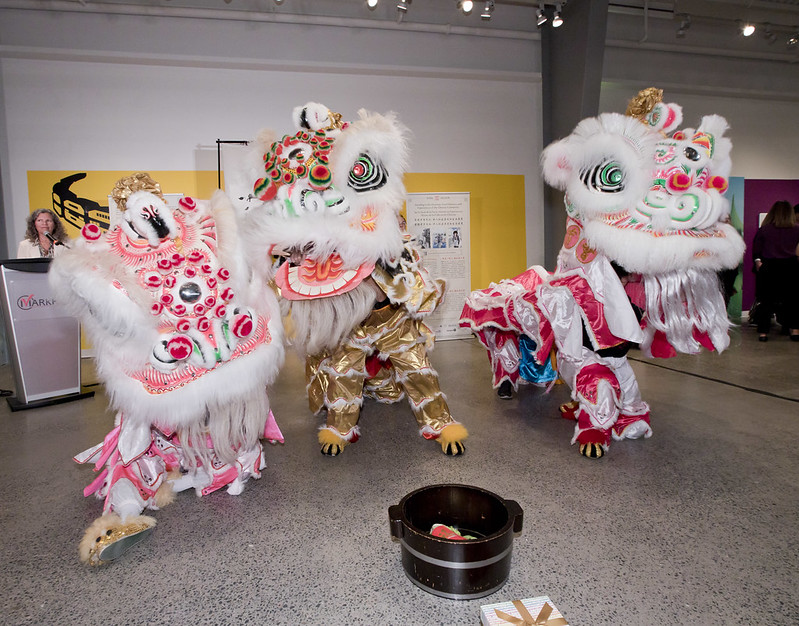 Three lion dancers perform at Markham Museum for the official opening of Standing in the Doorway: Lived Histories and Experiences of the Chinese Community, 2023. Courtesy of City of Markham.
Three lion dancers perform at Markham Museum for the official opening of Standing in the Doorway: Lived Histories and Experiences of the Chinese Community, 2023. Courtesy of City of Markham.
Often seen at Lunar New Year, parades, festivals and cultural events, the lion dance is an important ritual to bring good luck and drive away evil spirits. There are two styles of lion dance: Northern and Southern. A traditional dance includes lions, a Buddha or clown player and an instrumentals team. Lion dancing is very physically demanding, and kung fu clubs and practitioners have often been associated with the lion dance because of its athleticism and skill required to move to the music.
One well-known, local lion dance performer and trainer is Master Derek Cheung. At a very early age, Master Cheung showed a special interest and talent for Chinese Kung Fu. Throughout his life, he followed his passion for martial arts, and traditional Chinese medicine. In his 40 years of practicing and teaching Jow Ga Kung Fu (周家), he has won many championships, which led him to also follow a career as a professional stuntman. He was also the personal trainer for Chow Yun-Fat, Crouching Tiger, Hidden Dragon (2000).
Master Cheung also has a focus in health and wellness through his osteopathic clinic. He is the founder and chief coach of Skycastleisure Health & Wellness in Markham. He is a certified member of the Kowloon Chinese Herbalists Association of Hong Kong, and specializes in the treatment of asthma, nephropathy, and Dit-Da (traumatology). This training in traumatology and osteopathic medicine is very useful in the prevention and treatment of martial arts injuries.
At the official opening of the Standing in the Doorway exhibition, Master Cheung and members of his team performed a traditional southern lion dance to the delight of everyone attending.
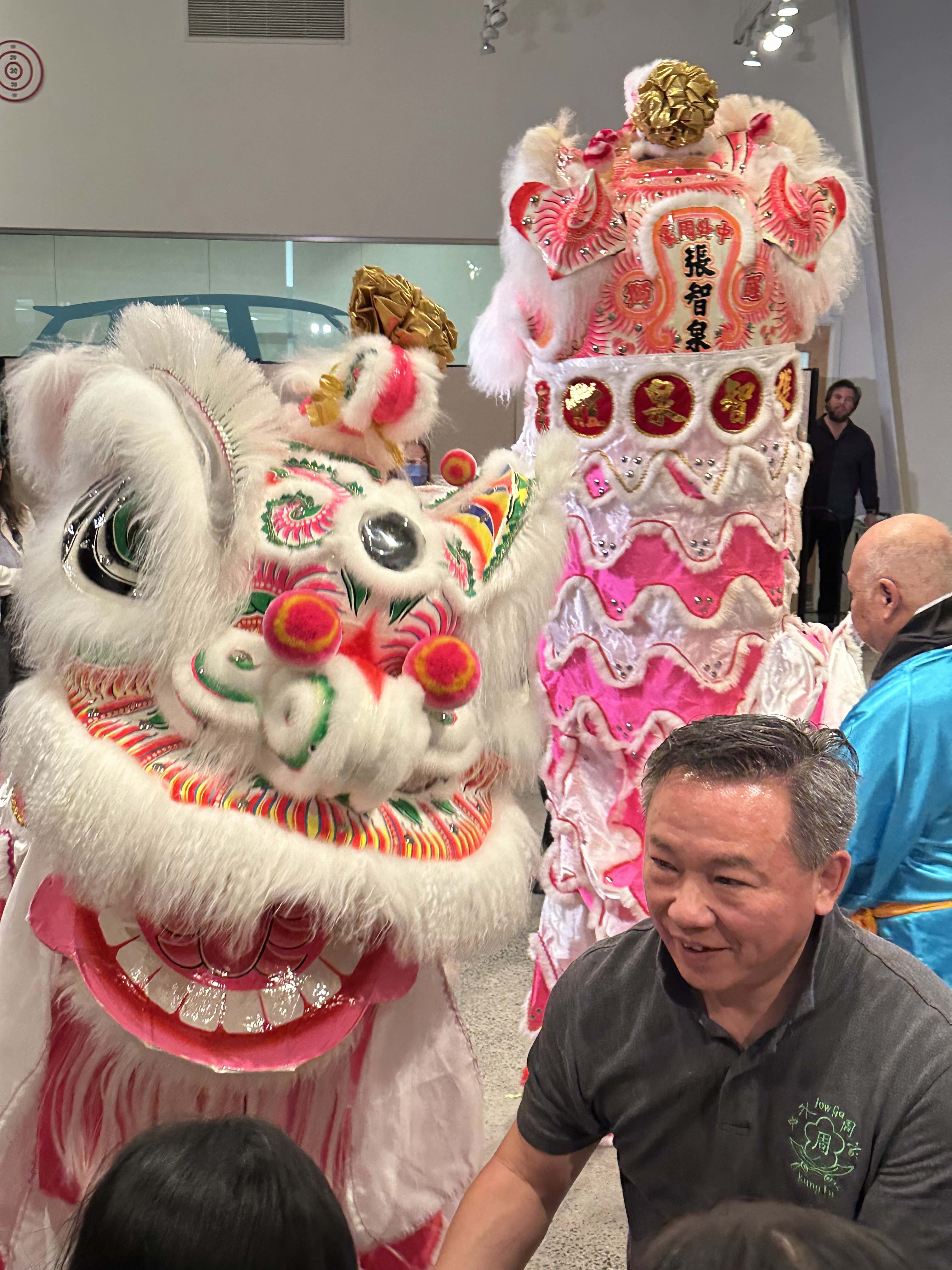 Lions are often offered "lucky" lettuce to eat and then spit out, symbolizing the spreading of wealth and prosperity. A red envelope is "fed" to the lion as a reward and to bring good luck. The lion dance troupe then hands out candy to the audience. Photograph courtesy of Lisa Wong.
Lions are often offered "lucky" lettuce to eat and then spit out, symbolizing the spreading of wealth and prosperity. A red envelope is "fed" to the lion as a reward and to bring good luck. The lion dance troupe then hands out candy to the audience. Photograph courtesy of Lisa Wong.
|
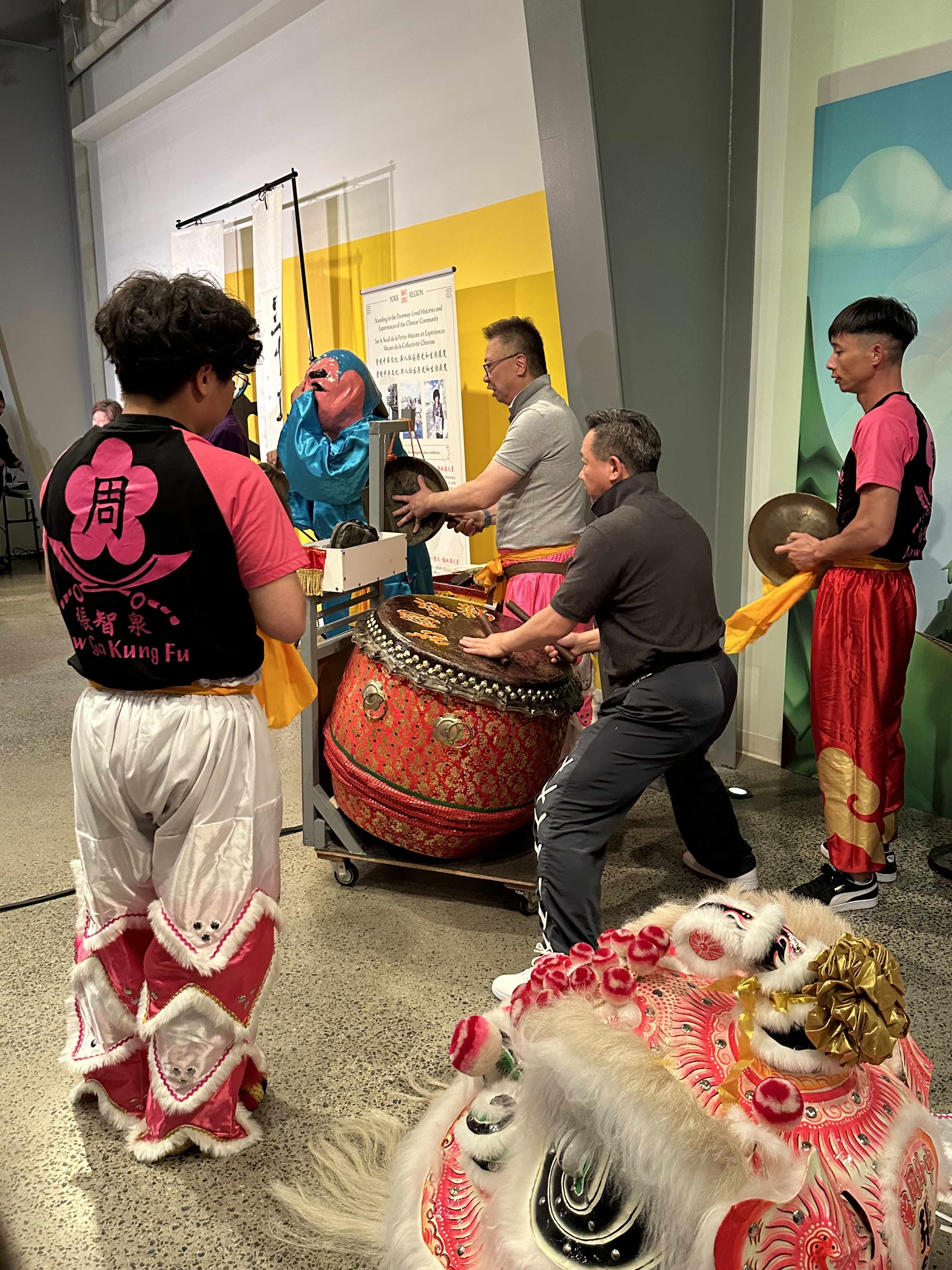 A traditional lion dance includes a gong, cymbal and drum. The special beat sets the pace of the dance and creates a celebratory atmosphere. Photograph courtesy of Lisa Wong.
A traditional lion dance includes a gong, cymbal and drum. The special beat sets the pace of the dance and creates a celebratory atmosphere. Photograph courtesy of Lisa Wong.
|
Home. Place. Belonging.
The importance of Chinese Canadians' contributions across Canada are even more than what can be written, as many intricate and personal stories exist in every aspect of the Chinese diaspora. The stories shared here are snippets of a rich culture that were shaped by exclusionary policies such as the Chinese Exclusion Act, and show the resilience and strength of family bonds and a deep dedication to the continuation of cultural traditions. Many diverse cultures can see parallels to their own journey to Canada and especially those here in York Region, as the most diverse area in the Country. Sometimes, when we take the time to learn about the people around us, we can see glimpses of ourselves - in the art, sports, music, dance, fashion, food or language - we see the value of traditions and love of family. Listen to Allan Tam as he talks about how he and his family have made Markham and York Region their home. Also listen to Dr. Ken Ng about how home is a place of safety, place and belonging: "Markham is my home. York Region is my home."
Fluxes of immigration will continue to change the landscape of York Region in the decades to come, where the current generations of community members will be important in helping newcomers settle in the area; where home, place and belonging will continue to be at the forefront of many peoples stories.


“My Blood is still Chinese, but my heart is Canadian. You make Canada your new home, and you really should not treat this as a second country, but your real country that you should serve, love, and give back to.”
— Nancy Siew
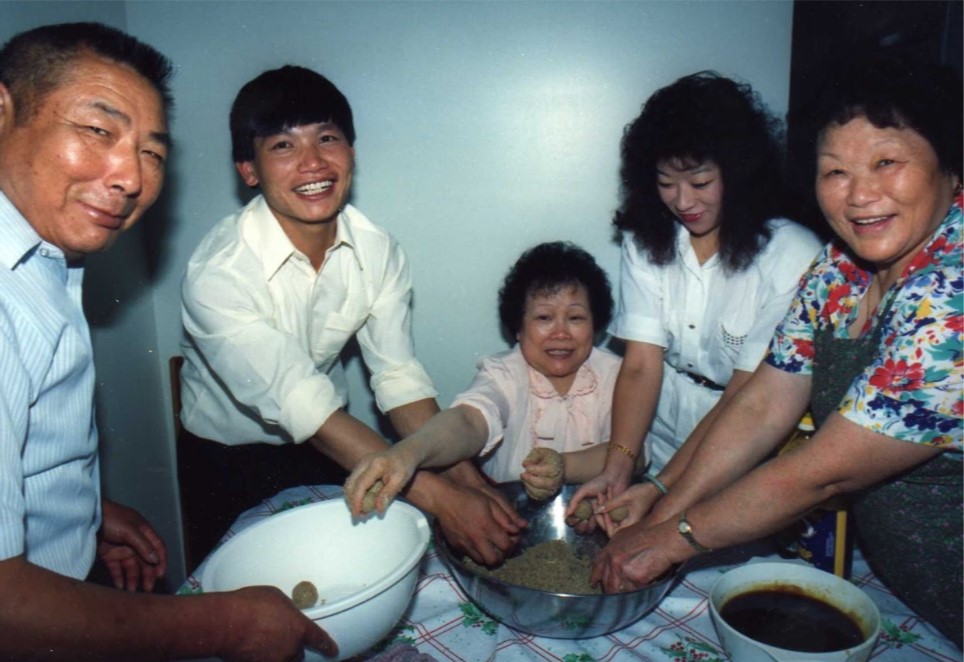 Carol Jean AUE and nephew with Harry Jim’s family preparing a traditional Chinese pastry, to celebrate the upcoming wedding of Madonna AUE and William Jim. Courtesy of Rita Tam.
Carol Jean AUE and nephew with Harry Jim’s family preparing a traditional Chinese pastry, to celebrate the upcoming wedding of Madonna AUE and William Jim. Courtesy of Rita Tam.